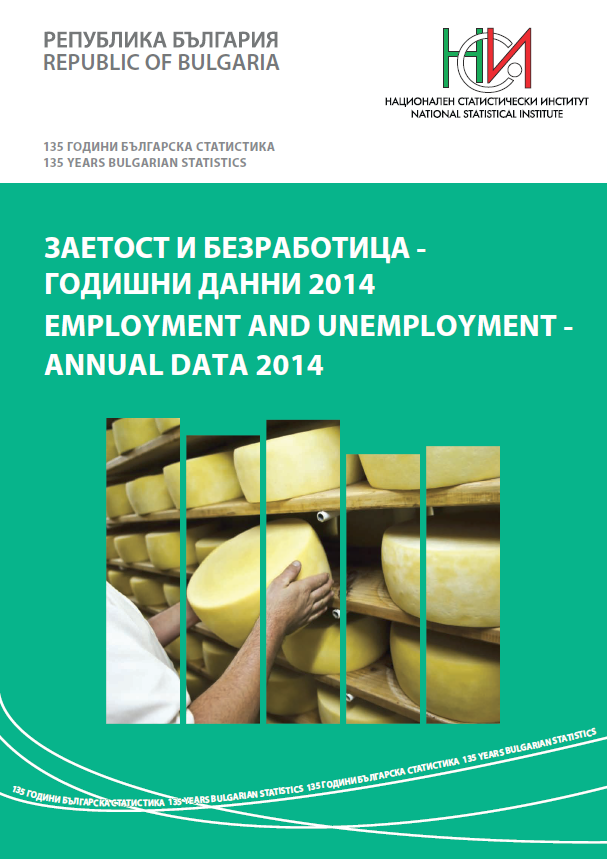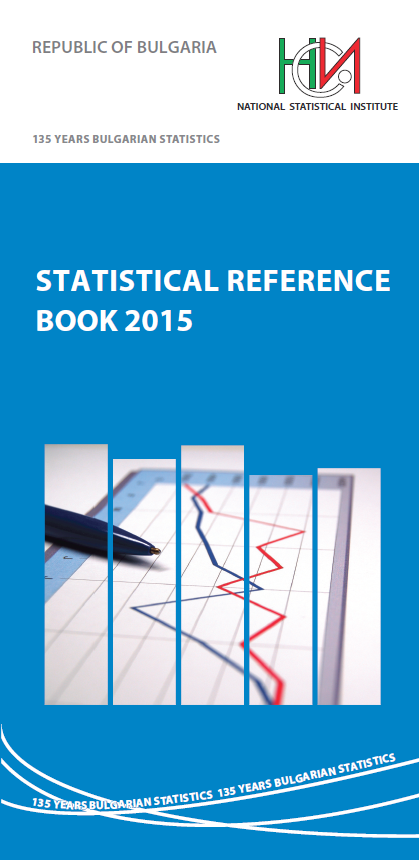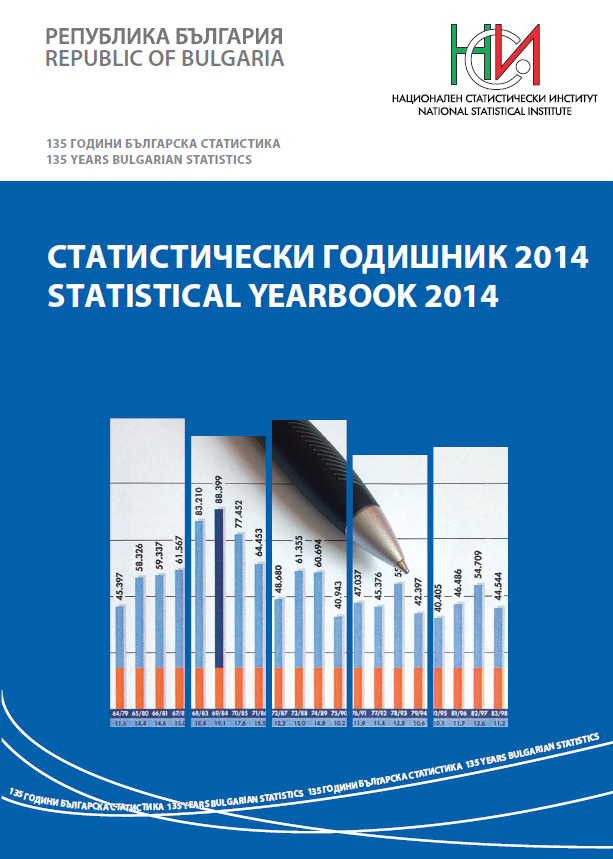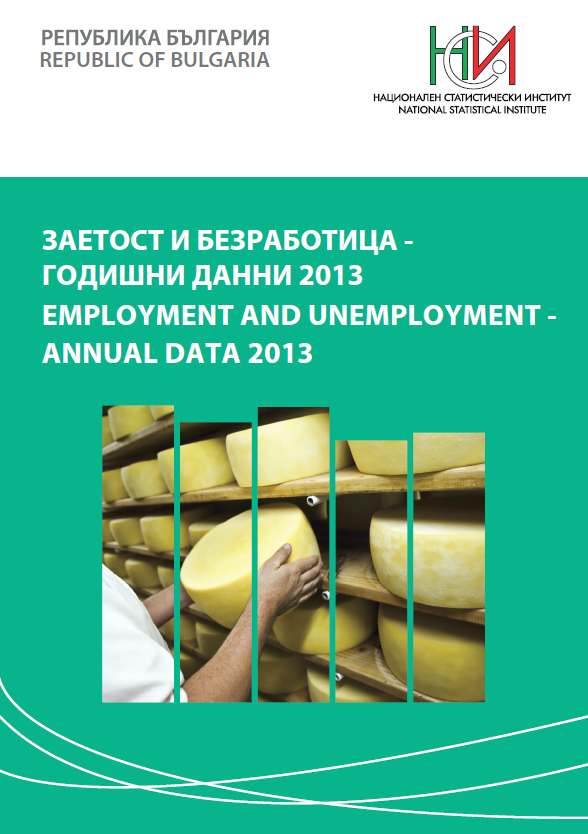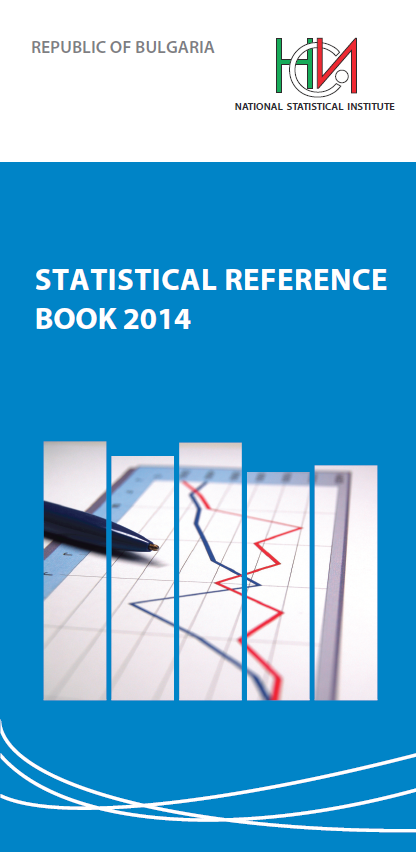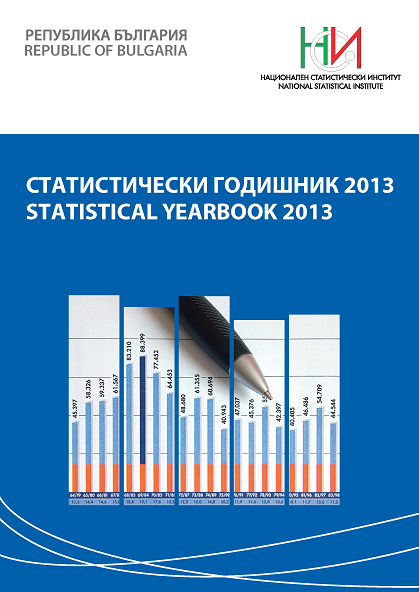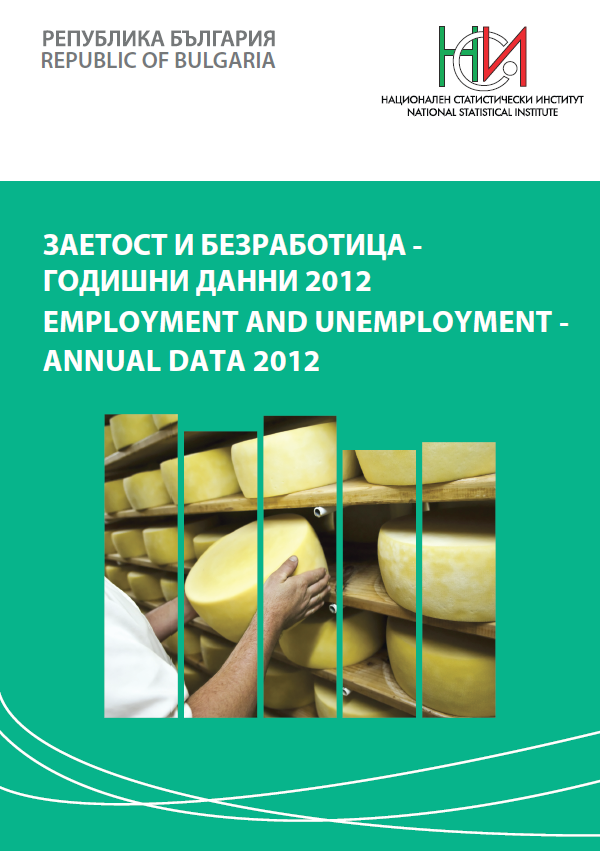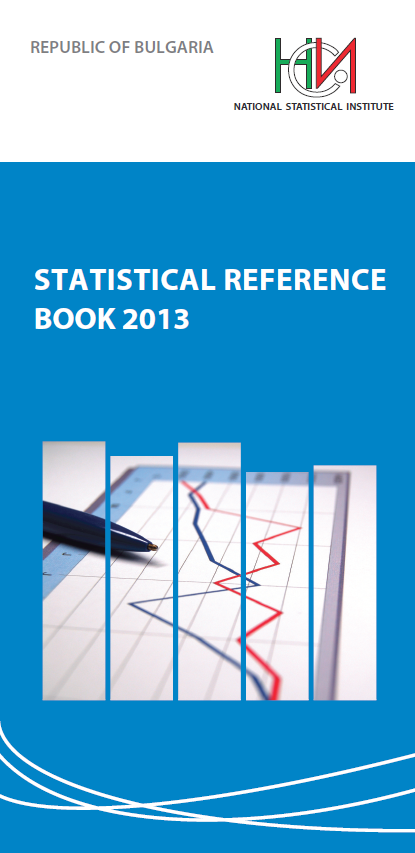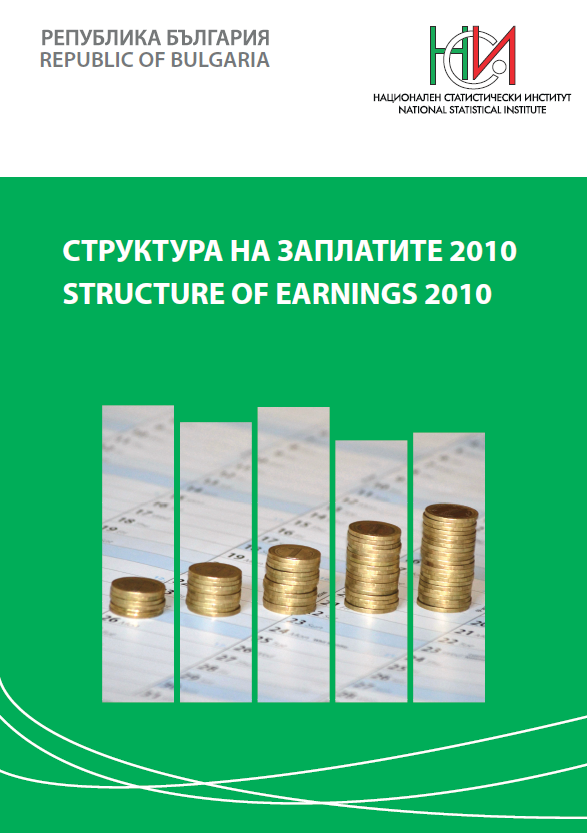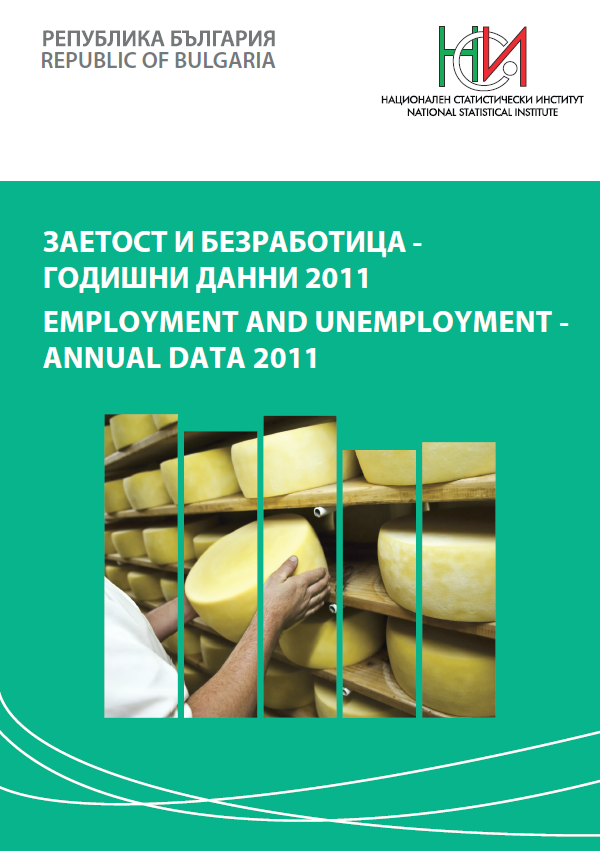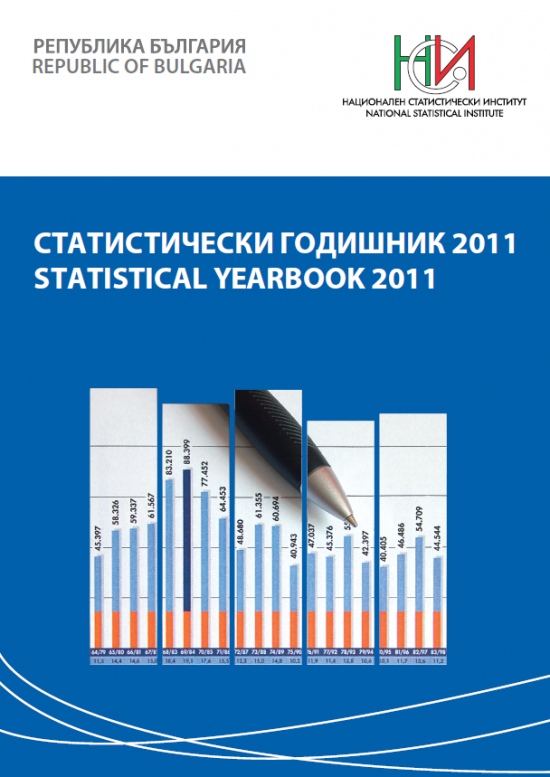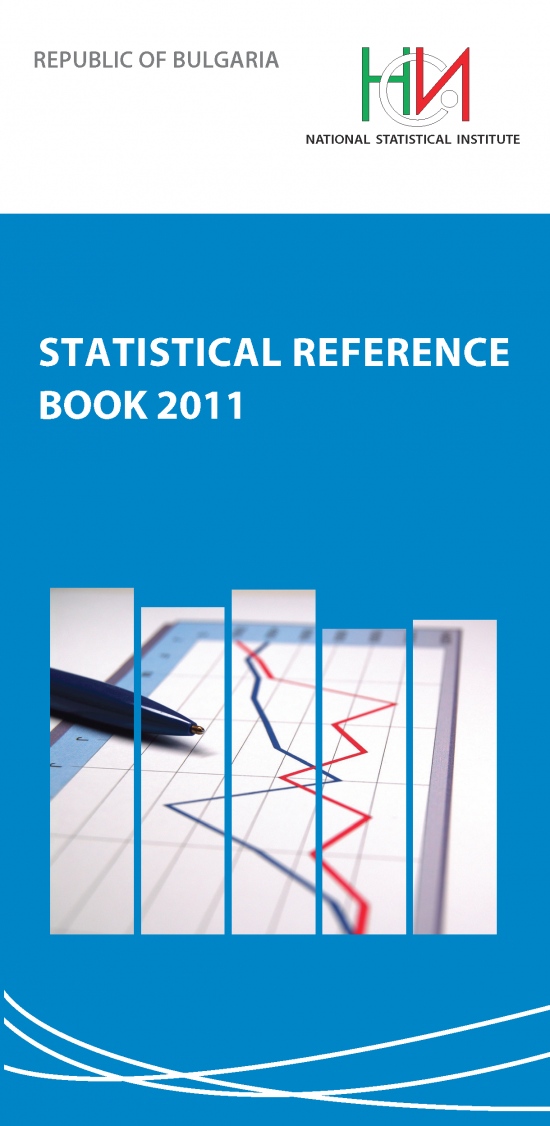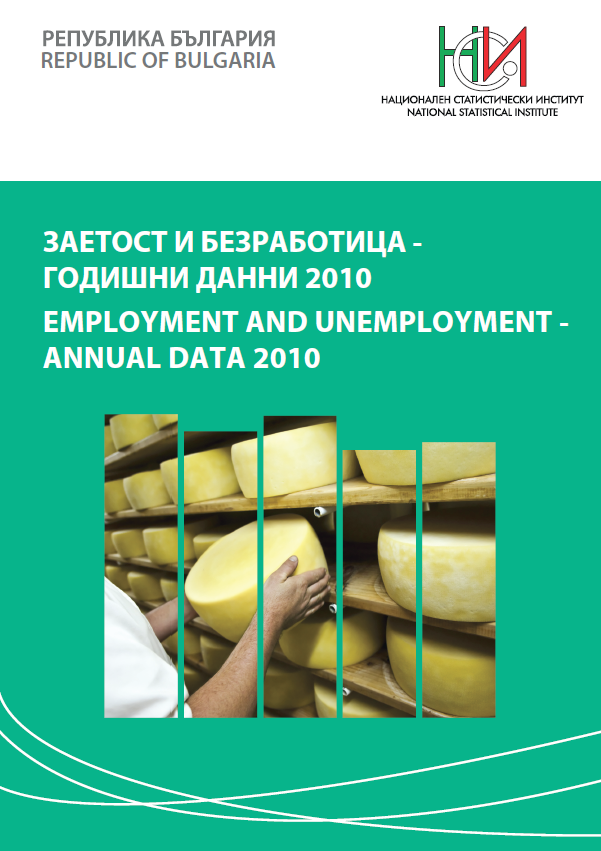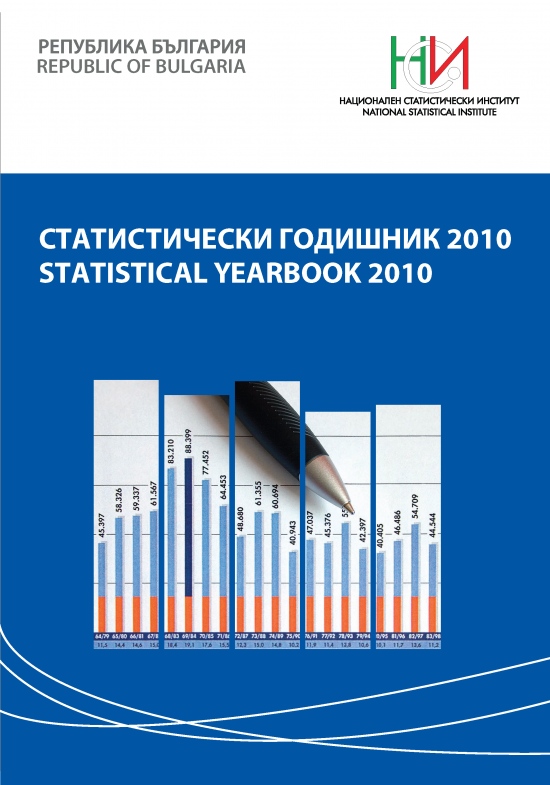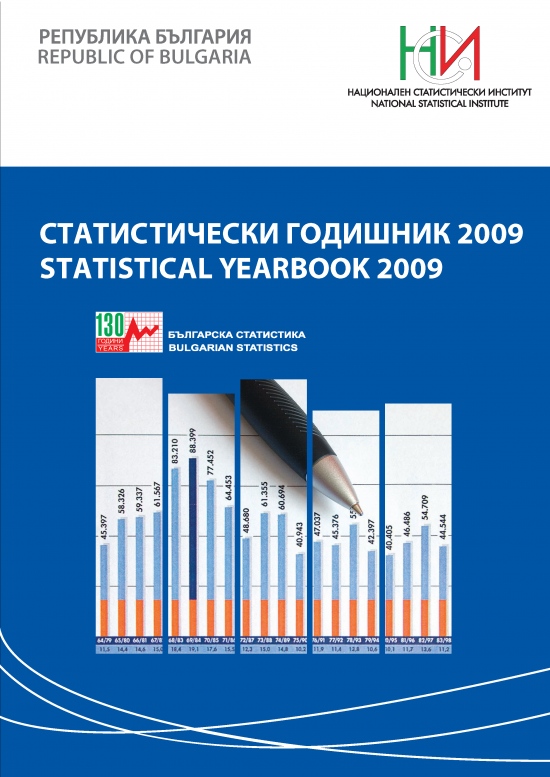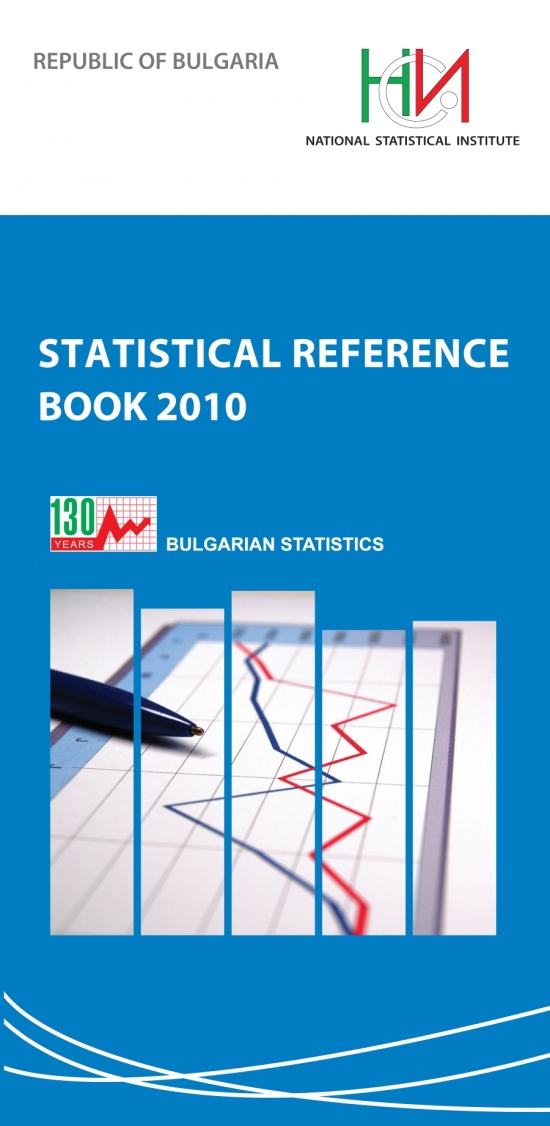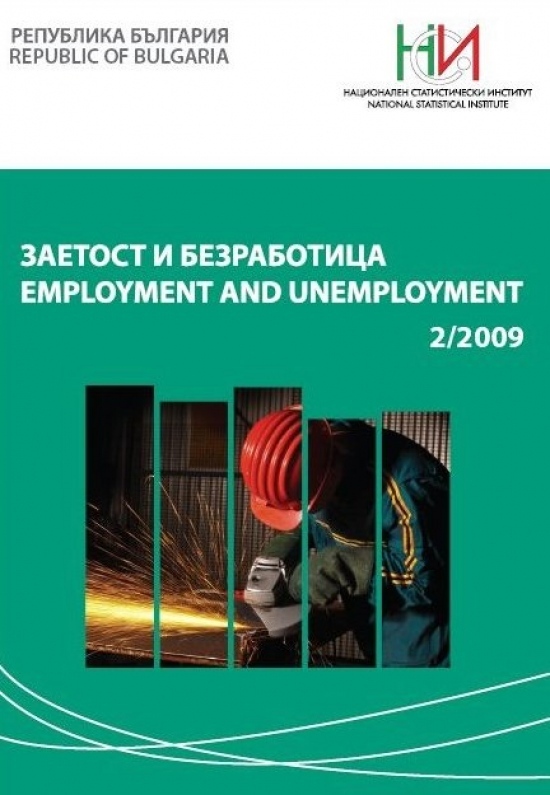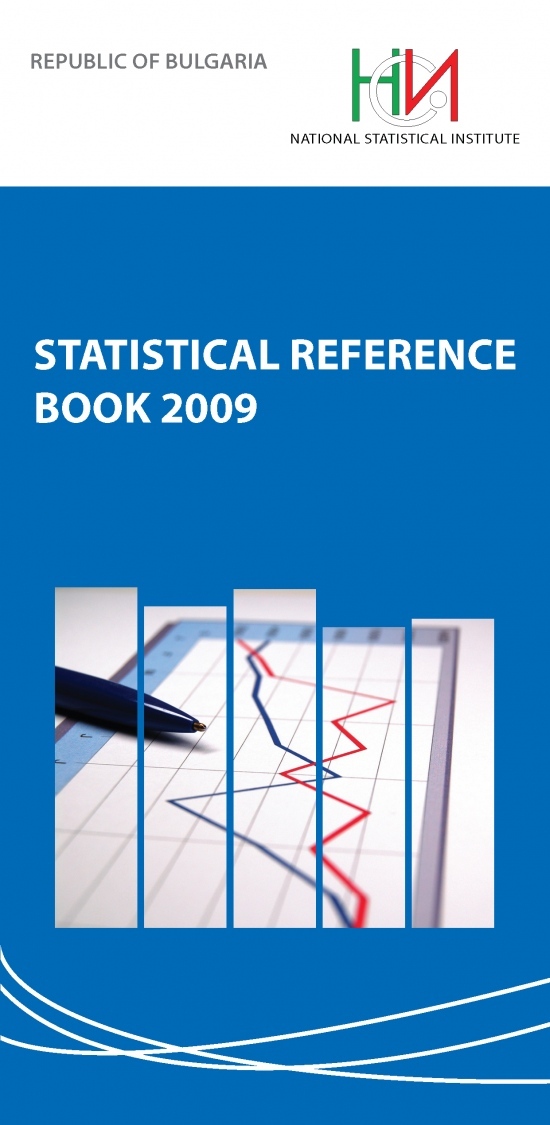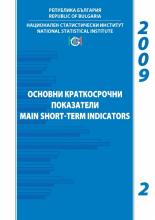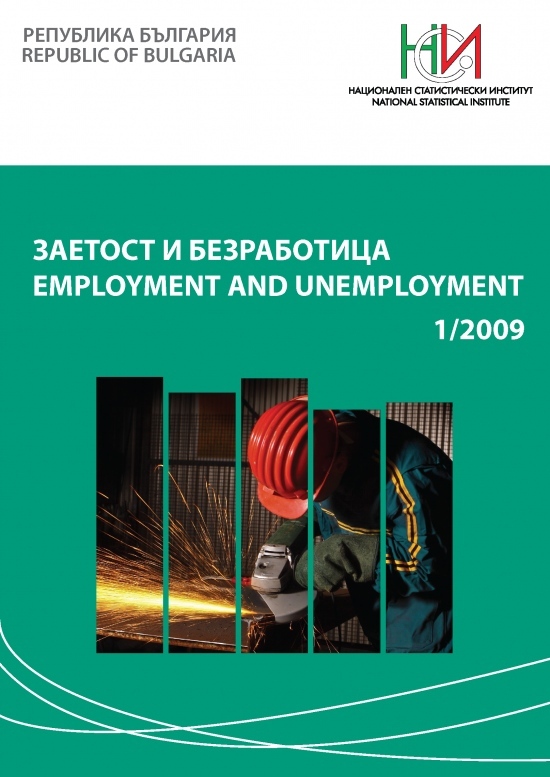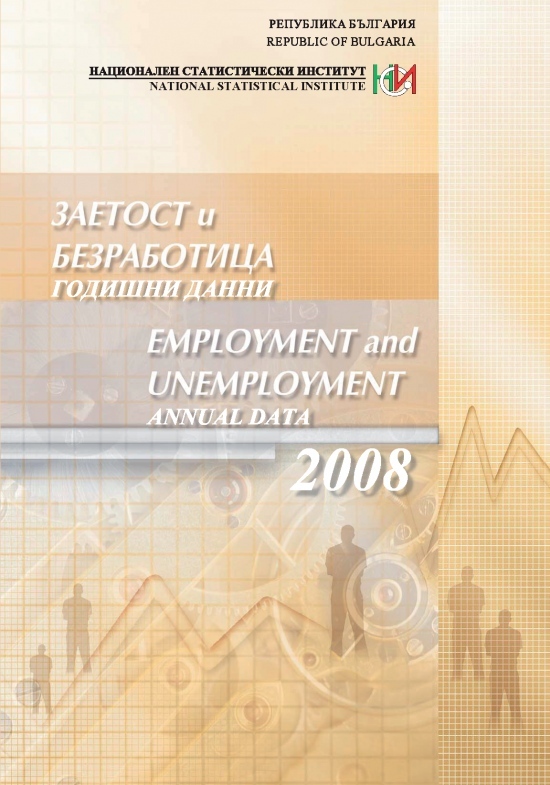Labour Cost Survey
| Economic activity | Total (Full-time and part-time)* | Full-time | Part-time* | |||
|---|---|---|---|---|---|---|
| Employees | Average annual wages and salaries | Employees | Average annual wages and salaries | Employees | Average annual wages and salaries | |
| Number | BGN | Number | BGN | Number | BGN | |
| Total | 2 202 770 | 15 976 | 1 990 350 | 17 059 | 212 420 | 5 828 |
| Mining and quarrying | 19 805 | 22 891 | 19 469 | 23 033 | 336 | 14 672 |
| Manufacturing | 470 145 | 14 041 | 445 889 | 14 478 | 24 256 | 6 004 |
| Electricity,gas,steam and air conditioning supply | 29 527 | 25 929 | 29 088 | 26 137 | 439 | 12 094 |
| Water supply,sewerage,waste management and remediation activities | 36 830 | 13 135 | 35 598 | 13 359 | 1 232 | 6 639 |
| Construction | 138 130 | 12 617 | 122 969 | 13 607 | 15 161 | 4 592 |
| Wholesale and retail trade;repair of motor vehicles and motorcycles | 372 142 | 13 668 | 327 476 | 14 817 | 44 666 | 5 240 |
| Transportation and storage | 150 389 | 13 216 | 136 738 | 14 075 | 13 651 | 4 606 |
| Accommodation and food service activities | 98 515 | 8 067 | 78 164 | 9 104 | 20 351 | 4 085 |
| Information and communication | 103 966 | 39 817 | 98 931 | 41 094 | 5 035 | 14 736 |
| Financial and insurance activities | 54 973 | 25 495 | 50 510 | 26 925 | 4 463 | 9 310 |
| Real estate activities | 23 998 | 14 025 | 20 064 | 15 675 | 3 934 | 5 614 |
| Professional,scientific and technical activities | 80 992 | 22 188 | 71 680 | 24 116 | 9 312 | 7 346 |
| Administrative and support service activities | 120 082 | 12 134 | 103 119 | 13 314 | 16 963 | 4 958 |
| Public administration and defence;compulsory social security | 111 045 | 19 188 | 107 959 | 19 571 | 3 086 | 5 761 |
| Education | 166 781 | 16 811 | 154 479 | 17 653 | 12 302 | 6 230 |
| Human health and social work activities | 153 166 | 15 784 | 129 748 | 17 262 | 23 418 | 7 592 |
| Arts,entertainment and recreation | 33 688 | 12 540 | 29 740 | 13 594 | 3 948 | 4 598 |
| Other service activities | 38 596 | 9 599 | 28 729 | 11 382 | 9 867 | 4 407 |
* Part-time employees are not converted into full-time equivalents |
||||||
| Labour Costs components | Total | Economic activity | |||||||
|---|---|---|---|---|---|---|---|---|---|
| Mining and quarrying | Manufacturing | Electricity,gas,steam and air conditioning supply | Water supply,sewerage,waste management and remediation activities | Construction | Wholesale and retail trade;repair of motor vehicles and motorcycles | ||||
| Total | 100.00 | 100.00 | 100.00 | 100.00 | 100.00 | 100.00 | 100.00 | ||
| Wages and salaries costs | 81.73 | 69.86 | 81.88 | 68.33 | 78.53 | 84.21 | 84.38 | ||
| of which: | Basic wages and salaries for days worked | 56.68 | 37.63 | 57.96 | 39.95 | 53.43 | 62.57 | 62.94 | |
| Bonuses | 9.21 | 9.63 | 9.01 | 6.77 | 7.11 | 11.13 | 9.83 | ||
| Payments for days not worked | 7.10 | 8.24 | 6.72 | 7.75 | 7.19 | 5.15 | 5.60 | ||
| Additional remunerations according to the Labour Code, State Officials Act or other legislative acts | 8.75 | 14.37 | 8.19 | 13.86 | 10.81 | 5.36 | 6.01 | ||
| Employers' actual social contributions | 14.89 | 18.30 | 15.01 | 16.46 | 15.32 | 14.20 | 13.91 | ||
| of which: | Statutory social-security contributions | 14.78 | 17.75 | 14.93 | 15.27 | 15.30 | 14.18 | 13.84 | |
| Collectively agreed, contractual and voluntary social-security contributions payable by the employer | 0.10 | 0.55 | 0.08 | 1.19 | 0.02 | 0.02 | 0.07 | ||
| Employers’ imputed social contributions | 1.67 | 2.52 | 1.47 | 3.33 | 2.15 | 1.21 | 1.11 | ||
| Other social expenses and benefits | 1.49 | 6.52 | 1.36 | 10.27 | 3.75 | 0.23 | 0.56 | ||
| Taxes regarded as labour costs | 0.02 | 0.04 | 0.03 | 0.07 | 0.03 | 0.00 | 0.00 | ||
| Vocational training costs | 0.06 | 0.12 | 0.07 | 0.09 | 0.10 | 0.01 | 0.03 | ||
| Other labour costs | 0.15 | 2.64 | 0.19 | 1.45 | 0.12 | 0.13 | 0.01 | ||
| Labour Costs components | Total | Economic activity | |||||||
|---|---|---|---|---|---|---|---|---|---|
| Transportation and storage | Accommodation and food service activities | Information and communication | Financial and insurance activities | Real estate activities | Professional,scientific and technical activities | ||||
| Total | 100.00 | 100.00 | 100.00 | 100.00 | 100.00 | 100.00 | 100.00 | ||
| Wages and salaries costs | 81.73 | 76.80 | 81.57 | 87.35 | 84.42 | 84.44 | 85.59 | ||
| of which: | Basic wages and salaries for days worked | 56.68 | 52.05 | 67.93 | 64.86 | 57.10 | 67.28 | 63.92 | |
| Bonuses | 9.21 | 7.32 | 2.94 | 11.14 | 13.83 | 5.46 | 9.46 | ||
| Payments for days not worked | 7.10 | 6.94 | 6.33 | 6.09 | 6.26 | 5.73 | 5.80 | ||
| Additional remunerations according to the Labour Code, State Officials Act or other legislative acts | 8.75 | 10.49 | 4.37 | 5.27 | 7.23 | 5.97 | 6.41 | ||
| Employers' actual social contributions | 14.89 | 16.45 | 15.61 | 10.80 | 12.42 | 13.51 | 12.37 | ||
| of which: | Statutory social-security contributions | 14.78 | 16.26 | 15.59 | 10.72 | 12.11 | 13.49 | 12.29 | |
| Collectively agreed, contractual and voluntary social-security contributions payable by the employer | 0.10 | 0.19 | 0.02 | 0.07 | 0.31 | 0.02 | 0.08 | ||
| Employers’ imputed social contributions | 1.67 | 1.96 | 2.29 | 1.03 | 1.45 | 1.42 | 1.32 | ||
| Other social expenses and benefits | 1.49 | 4.58 | 0.52 | 0.64 | 1.36 | 0.61 | 0.67 | ||
| Taxes regarded as labour costs | 0.02 | 0.11 | 0.00 | 0.01 | 0.01 | 0.01 | 0.01 | ||
| Vocational training costs | 0.06 | 0.05 | 0.00 | 0.10 | 0.30 | 0.00 | 0.03 | ||
| Other labour costs | 0.15 | 0.06 | 0.01 | 0.06 | 0.04 | 0.01 | 0.03 | ||
| Labour Costs components | Total | Economic activity | |||||||
|---|---|---|---|---|---|---|---|---|---|
| Administrative and support service activities | Public administration and defence;compulsory social security | Education | Human health and social work activities | Arts,entertainment and recreation | Other service activities | ||||
| Total | 100.00 | 100.00 | 100.00 | 100.00 | 100.00 | 100.00 | 100.00 | ||
| Wages and salaries costs | 81.73 | 83.04 | 74.76 | 78.34 | 82.88 | 83.22 | 82.95 | ||
| of which: | Basic wages and salaries for days worked | 56.68 | 62.06 | 52.18 | 42.08 | 44.28 | 60.30 | 67.38 | |
| Bonuses | 9.21 | 10.29 | 7.94 | 7.21 | 11.18 | 5.73 | 3.75 | ||
| Payments for days not worked | 7.10 | 5.37 | 7.53 | 14.55 | 7.17 | 8.29 | 5.98 | ||
| Additional remunerations according to the Labour Code, State Officials Act or other legislative acts | 8.75 | 5.32 | 7.10 | 14.49 | 20.25 | 8.90 | 5.83 | ||
| Employers' actual social contributions | 14.89 | 14.56 | 21.64 | 17.25 | 14.74 | 14.24 | 15.54 | ||
| of which: | Statutory social-security contributions | 14.78 | 14.51 | 21.64 | 17.25 | 14.74 | 14.24 | 15.52 | |
| Collectively agreed, contractual and voluntary social-security contributions payable by the employer | 0.10 | 0.05 | 0.00 | 0.00 | 0.00 | 0.00 | 0.02 | ||
| Employers’ imputed social contributions | 1.67 | 1.33 | 2.13 | 3.18 | 1.70 | 2.01 | 1.18 | ||
| Other social expenses and benefits | 1.49 | 1.03 | 1.39 | 1.11 | 0.61 | 0.52 | 0.33 | ||
| Taxes regarded as labour costs | 0.02 | 0.00 | 0.02 | 0.01 | 0.00 | 0.00 | 0.00 | ||
| Vocational training costs | 0.06 | 0.02 | 0.03 | 0.08 | 0.02 | 0.00 | 0.00 | ||
| Other labour costs | 0.15 | 0.02 | 0.03 | 0.04 | 0.04 | 0.00 | 0.01 | ||
Euro-SDMX Metadata Structure (ESMS)
| Contact | |
|---|---|
| Contact organisation | National Statistical Institute |
| Contact organisation unit | Statistics on Labour costs, Research and Development, Innovation and Information Society Department |
| Contact name | Todor Davidkov |
| Contact person function | Head of department |
| Contact mail address | 2, P. Volov Str.; 1038 Sofia, Bulgaria |
| Contact email address | |
| Contact phone number | +359 2 9857 568 |
| Contact fax number | |
| Metadata update | |
| Metadata last certified | 19 February 2024 |
| Metadata last posted | 19 February 2024 |
| Metadata last update | 19 February 2024 |
| Statistical presentation | |
| Data description | The Labour Cost Survey is aimed to give detailed and comparable at European Union level information on distribution of employers' labour costs incurred on behalf of their employees. Objects of the survey are: characteristics of employer (enterprise, local unit) - number of employees in the local unit, type of ownership, size of the enterprise, employees distribution by gender and mode of employment (full-time/part-time), paid days, wages and salaries costs, social security costs, employers' imputed social contributions, payments in kind, vocational training costs and other labour costs. |
| Classification system | · National Classification of Economic Activities (NCEA-2003, for international use NACE.BG 2003); · Classification of Economic Activities (CEA-2008, for international use NACE.BG 2008). |
| Sector coverage | Covered are enterprises (local units) from all economic activities except "Agriculture, hunting, forestry and fishing". |
| Statistical concepts and definitions | Employees are all persons who have a labour contract (fixed or permanent; full-time or part-time) with their employer by virtue of the Labour Code or the Civil Servants Act and who receive remuneration in cash or in kind for certain quality and quantity of work done. Number of employees excludes:
Full-time employees are those whose regular working hours are the same as collectively agreed or customary hours worked in the observed local unit or for certain occupational groups. Part-time employees (half-day, half-week, half-month) are those whose regular working hours (daily, weekly, monthly) is less then collectively agreed or customary hours for the observed local unit or occupational group. Days worked - the total number of days worked by all employees under labour contract during the reference year. For a day worked is considered every day spent on work irrespective of the number of actual hours spent. Days not worked but nevertheless paid by the employer - the number of days not worked due to annual holydays/vacation, absence due to sickness (if it is paid by the employer), public holydays and other paid but not work days. Hour actually worked - the total number of hours worked by all employees during the year. Hours actually worked are defined as the sum of all periods spent on direct and ancillary activities to produce goods and services. Total Labour Costs includes wages and salaries paid by the employer in cash or in kind, employers' actual and imputed social contribution, taxes regarded as labour costs, vocational training costs and other labour costs. Gross annual wages and salaries are the remunerations paid regularly to the employees by the employers before the deduction of any tax and social security contributions payable by the employees and withheld by the employers. Gross wages and salaries comprise of: - basic wages and salaries for time worked or work done; - payments for statutory, contractual or voluntary leave; - payments for overtime; - additional payments for shift work, extreme working conditions, length of service etc.; - monthly, quarterly and annual bonuses. Employers' statutory social-security contributions. These consist of payments made compulsory by law and payable by employers for the benefit of their employees to social-security institutions. They include contributions to insurance schemes for retirement pension, sickness, maternity and disability, to unemployment insurance schemes, to insurance schemes for occupational accidents and diseases etc. Collectively agreed, contractual and voluntary social-security contributions payable by the employer - these are all contributions paid by the employer to social-security schemes which are supplementary to those which are compulsory by law. They include supplementary pension sickness and unemployment insurance schemes. Employers' imputed social contributions these are payments made directly by employers to their employees or former employees without involving a social-security fund. Instead, the benefits are paid out of the own resources of the employers. Examples for such payments are: guaranteed remuneration in the event of sickness (for the first three days), payments to employees leaving the enterprise, payments made to employees on retirement etc. Social expenses and benefits (payments in kind) - this variable refers to an estimate of the value of all goods and services made available to employees through the employer. It includes, meal vouchers, company products, staff housing, covering transport expenses between home and work place, company cars, etc. Vocational training costs paid by the employer - these include: expenditure on vocational-training services and facilities small repairs and maintenance of buildings and installations, excluding staff costs; expenditure on participation in courses; the fees of instructors from outside the enterprise; expenditure on teaching aids and tools used for training; sums paid by the enterprise to vocational-training organizations, etc. Other expenditure paid by the employer - this includes in particular: recruitment costs (these are the sums paid to recruitment agencies, expenditure on job advertisements in the press, travel expenses paid to candidates called for interview, installation allowances paid to newly recruited staff, and working clothes provided by the employer. |
| Statistical unit | The observation units are enterprises - companies, ministries, departments, political, religious, public and other organizations, that perform economical activities in Republic of Bulgaria during the reference year. |
| Statistical population | The labour costs statistics is based on the survey on the employees, wages and salaries and other labour costs, which is an exhaustive for all public and private sector enterprises irrespective of their economic activity and the legislation according to which they are founded. |
| Reference area | The whole country is covered. |
| Time coverage | 2004, 2008, 2012, 2016,2020 |
| Base period | Not applicable. |
| Unit of measure | |
Numbers, percent, BGN | |
| Reference period | |
Calendar year | |
| Institutional mandate | |
| Legal acts and other agreements | · Law on Statistics; · National Statistical Programme; · Council Regulation (EC) No 530/1999 of 9 March 1999 concerning structural statistics on earnings and on labour costs;
· Commission Regulation (EC) No 1737/2005 of 21 October 2005 amending Regulation (EC) No 1726/1999 as regards the definition and transmission of information on labour costs. |
| Data sharing | Not applicable. |
| Confidentiality | |
| Confidentiality - policy | · Law on Statistics; · Regulation (EC) No 223/2009 of the European Parliament and of the Council of 11 March 2009 on European statistics (provision 24 and Article 20 (4)) (OJ L 87, p. 164), stipulates the necessity to establish common principles and guidelines ensuring the confidentiality of data used for the production of European statistics and the access to those confidential data with due account for technical developments and the requirements of users in a democratic society. |
| Confidentiality - data treatment | Individual data are not disseminated following the rules set in Article 25 from the Law on Statistics. The dissemination of individual data is done only under Article 26 from the same law. |
| Release policy | |
| Release calendar | The actual date of data publication is set in the National Statistical Institute Release Calendar. |
| Release calendar access | The calendar is available on the NSI website: https://www.nsi.bg/en/node/480 |
| User access | The data are published on the NSI website, section Labour Market in accordance with the Law on Statistics and the European Statistics Code of Practice respecting the professional independence and aimed at objectivity, transparency and equal treatment of all consumers. |
| Frequency of dissemination | |
Every four years. | |
| Accessibility and clarity | |
| News release | Not applicable. |
| Publications | |
| On-line database | Detailed results are available to all users of the NSI website under the heading Labour Market - Annual statistics on employment and labour cost - Labour Costs: https://www.nsi.bg/en/node/6463 |
| Micro-data access | Access to anonymised micro-data can be granted for research and scientific purposes upon request and following the Rules for granting access to anonymised micro-data for scientific and research purposes set by NSI. |
| Other | Not applicable. |
| Documentation on methodology | |
| Quality documentation | |
| Quality management | |
| Quality assurance | According to Article 2, point 3 from the Law on Statistics the statistical information shall be produced in compliance with the following criteria for quality: adequacy, accuracy, timeliness, punctuality, accessibility and clarity, comparability and logical consistency. According to Article 10 from Council Regulation (EC) No 530/1999 of 9 March 1999 concerning structural statistics on earnings and on labour costs the national authorities shall ensure that the results reflect the true situation of the total population of units with a sufficient degree of representativity. The national authorities shall forward to Eurostat at its request after each reference period a report containing all relevant information relating to the implementation of the Regulation in the Member State concerned, to enable the quality of the statistics to be evaluated. |
| Quality assessment | According to Commission Regulation (EC) No 698/2006 of 5 May 2006 implementing Council Regulation (EC) No 530/1999 as regards quality evaluation of structural statistics on labour costs and earnings each Member State shall prepare a quality report for the labour cost survey 24 months after the reference period. |
| Relevance | |
| User needs | The users groups are defined on the basis of the received data requests. They can be classified in the following main groups:
Internal users: Structural Business Statistics, National Accounts. |
| User satisfaction | No information available. |
| Completeness | All mandatory variables according to the Commission Regulation (EC) No 1737/2005 are covered. As regards the size class of enterprise and economic activity coverage, the small enterprises (with less than 10 employees) are included in the survey as well all economic activities from NACE.BG 2008 section B to S. |
| Accuracy and reliability | |
| Overall accuracy | The overall accuracy of the survey results depends of:
|
| Sampling error | Not applicable - the survey is exhaustive. |
| Non-sampling error | After the consolidation of regional databases into national one additional checks are done for identification of duplicate cases, which are deleted from the database. |
| Timeliness and punctuality | |
| Timeliness | The survey results are published 18 months after the reference period. |
| Punctuality | The survey results are presented at the actual date set in the National Statistical Institute Release Calendar or with minimal delay. |
| Coherence and comparability | |
| Comparability - geographical | The national and regional statistical data on employees, wages and salaries and labour costs are in compliance with the acting Classification of territorial units for statistical purposes in Bulgaria (NUTS). |
| Comparability - over time | The comparability over time is disturbed by the changes of the Classification of Economic Activities. |
| Coherence - cross domain | All indicators are internal coherent. |
| Coherence - internal | There are other statistical surveys that produce information on number of employees, wages and salaries and labour costs:
The results from Labour Cost Survey are relatively comparable with the above mentioned surveys due to the following main methodological differences: purpose of the survey; statistical unit, definition of variables, reference period, methods of data classification by economic activity, methods of data collection and calculation of weights.
|
| Cost and burden | |
No information is available for the respondents' burden. | |
| Data revision | |
| Data revision - policy | Not applicable. |
| Data revision - practice | Not applicable. |
| Statistical processing | |
| Source data | The data source is the annual survey on Number of employees, wages and salaries and other labour costs as every four years additional variable are added to the survey to collect more detailed information on labour costs and comply with EU legislation in the field. |
| Frequency of data collection | Four-yearly |
| Data collection | The survey is exhaustive for all public and private sector enterprises. |
| Data validation | The data validation goes through three stages:
|
| Data compilation | The data processing goes through the following stages:
|
| Adjustment | Not applicable. |
| Comment | |
ESS Standard for Quality Reports Structure (ESQRS)
| Contact | |
|---|---|
| Contact organisation | National Statistical Institute |
| Contact organisation unit | Statistics on Labour costs, Research and Development, Innovation and Information Society Department |
| Contact name | Todor Davidkov |
| Contact person function | Head of department |
| Contact mail address | 2, P. Volov Str.; 1038 Sofia, Bulgaria |
| Contact email address | |
| Contact phone number | +359 2 9857 568 |
| Contact fax number | |
| Statistical presentation | |
| Data description | The Labour Cost Survey is aimed to give detailed and comparable at European Union level information on distribution of employers' labour costs incurred on behalf of their employees. Objects of the survey are: characteristics of employer (enterprise, local unit) - number of employees in the local unit, type of ownership, size of the enterprise, employees distribution by gender and mode of employment (full-time/part-time), paid days, wages and salaries costs, social security costs, employers' imputed social contributions, payments in kind, vocational training costs and other labour costs. |
| Classification system | · National Classification of Economic Activities (NCEA-2003, for international use NACE.BG 2003); · Classification of Economic Activities (CEA-2008, for international use NACE.BG 2008). |
| Sector coverage | Covered are enterprises (local units) from all economic activities except "Agriculture, hunting, forestry and fishing". |
| Statistical concepts and definitions | Employees are all persons who have a labour contract (fixed or permanent; full-time or part-time) with their employer by virtue of the Labour Code or the Civil Servants Act and who receive remuneration in cash or in kind for certain quality and quantity of work done. Number of employees excludes:
Full-time employees are those whose regular working hours are the same as collectively agreed or customary hours worked in the observed local unit or for certain occupational groups. Part-time employees (half-day, half-week, half-month) are those whose regular working hours (daily, weekly, monthly) is less then collectively agreed or customary hours for the observed local unit or occupational group. Days worked - the total number of days worked by all employees under labour contract during the reference year. For a day worked is considered every day spent on work irrespective of the number of actual hours spent. Days not worked but nevertheless paid by the employer - the number of days not worked due to annual holydays/vacation, absence due to sickness (if it is paid by the employer), public holydays and other paid but not work days. Hour actually worked - the total number of hours worked by all employees during the year. Hours actually worked are defined as the sum of all periods spent on direct and ancillary activities to produce goods and services. Total Labour Costs includes wages and salaries paid by the employer in cash or in kind, employers' actual and imputed social contribution, taxes regarded as labour costs, vocational training costs and other labour costs. Gross annual wages and salaries are the remunerations paid regularly to the employees by the employers before the deduction of any tax and social security contributions payable by the employees and withheld by the employers. Gross wages and salaries comprise of: - basic wages and salaries for time worked or work done; - payments for statutory, contractual or voluntary leave; - payments for overtime; - additional payments for shift work, extreme working conditions, length of service etc.; - monthly, quarterly and annual bonuses. Employers' statutory social-security contributions. These consist of payments made compulsory by law and payable by employers for the benefit of their employees to social-security institutions. They include contributions to insurance schemes for retirement pension, sickness, maternity and disability, to unemployment insurance schemes, to insurance schemes for occupational accidents and diseases etc. Collectively agreed, contractual and voluntary social-security contributions payable by the employer - these are all contributions paid by the employer to social-security schemes which are supplementary to those which are compulsory by law. They include supplementary pension sickness and unemployment insurance schemes. Employers' imputed social contributions these are payments made directly by employers to their employees or former employees without involving a social-security fund. Instead, the benefits are paid out of the own resources of the employers. Examples for such payments are: guaranteed remuneration in the event of sickness (for the first three days), payments to employees leaving the enterprise, payments made to employees on retirement etc. Social expenses and benefits (payments in kind) - this variable refers to an estimate of the value of all goods and services made available to employees through the employer. It includes, meal vouchers, company products, staff housing, covering transport expenses between home and work place, company cars, etc. Vocational training costs paid by the employer - these include: expenditure on vocational-training services and facilities small repairs and maintenance of buildings and installations, excluding staff costs; expenditure on participation in courses; the fees of instructors from outside the enterprise; expenditure on teaching aids and tools used for training; sums paid by the enterprise to vocational-training organizations, etc. Other expenditure paid by the employer - this includes in particular: recruitment costs (these are the sums paid to recruitment agencies, expenditure on job advertisements in the press, travel expenses paid to candidates called for interview, installation allowances paid to newly recruited staff, and working clothes provided by the employer. |
| Statistical unit | The observation units are enterprises - companies, ministries, departments, political, religious, public and other organizations, that perform economical activities in Republic of Bulgaria during the reference year. |
| Statistical population | The labour costs statistics is based on the survey on the employees, wages and salaries and other labour costs, which is an exhaustive for all public and private sector enterprises irrespective of their economic activity and the legislation according to which they are founded. |
| Reference area | The whole country is covered. |
| Time coverage | 2004, 2008, 2012, 2016,2020 |
| Base period | Not applicable. |
| Statistical processing | |
| Source data | The data source is the annual survey on Number of employees, wages and salaries and other labour costs as every four years additional variable are added to the survey to collect more detailed information on labour costs and comply with EU legislation in the field. |
| Frequency of data collection | Four-yearly |
| Data collection | The survey is exhaustive for all public and private sector enterprises. |
| Data validation | The data validation goes through three stages:
|
| Data compilation | The data processing goes through the following stages:
|
| Adjustment | Not applicable. |
| Quality management | |
| Quality assurance | According to Article 2, point 3 from the Law on Statistics the statistical information shall be produced in compliance with the following criteria for quality: adequacy, accuracy, timeliness, punctuality, accessibility and clarity, comparability and logical consistency. According to Article 10 from Council Regulation (EC) No 530/1999 of 9 March 1999 concerning structural statistics on earnings and on labour costs the national authorities shall ensure that the results reflect the true situation of the total population of units with a sufficient degree of representativity. The national authorities shall forward to Eurostat at its request after each reference period a report containing all relevant information relating to the implementation of the Regulation in the Member State concerned, to enable the quality of the statistics to be evaluated. |
| Quality assessment | According to Commission Regulation (EC) No 698/2006 of 5 May 2006 implementing Council Regulation (EC) No 530/1999 as regards quality evaluation of structural statistics on labour costs and earnings each Member State shall prepare a quality report for the labour cost survey 24 months after the reference period. |
| Relevance | |
| User needs | The users groups are defined on the basis of the received data requests. They can be classified in the following main groups:
Internal users: Structural Business Statistics, National Accounts. |
| User satisfaction | No information available. |
| Completeness | All mandatory variables according to the Commission Regulation (EC) No 1737/2005 are covered. As regards the size class of enterprise and economic activity coverage, the small enterprises (with less than 10 employees) are included in the survey as well all economic activities from NACE.BG 2008 section B to S. |
| Data completeness - rate | |
| Accuracy and reliability | |
| Overall accuracy | The overall accuracy of the survey results depends of:
|
| Sampling error | Not applicable - the survey is exhaustive. |
| Sampling errors - indicators | |
| Non-sampling error | After the consolidation of regional databases into national one additional checks are done for identification of duplicate cases, which are deleted from the database. |
| Coverage error | |
| Over-coverage - rate | |
| Common units - proportion | |
| Measurement error | |
| Non response error | |
| Unit non-response - rate | |
| Item non-response - rate | |
| Processing error | |
| Imputation - rate | |
| Model assumption error | |
| Seasonal adjustment | |
| Data revision - policy | Not applicable. |
| Data revision - practice | Not applicable. |
| Data revision - average size | |
| Timeliness and punctuality | |
| Timeliness | The survey results are published 18 months after the reference period. |
| Time lag - first results | |
| Time lag - final results | |
| Punctuality | The survey results are presented at the actual date set in the National Statistical Institute Release Calendar or with minimal delay. |
| Punctuality - delivery and publication | |
| Coherence and comparability | |
| Comparability - geographical | The national and regional statistical data on employees, wages and salaries and labour costs are in compliance with the acting Classification of territorial units for statistical purposes in Bulgaria (NUTS). |
| Asymmetry for mirror flows statistics - coefficient | |
| Comparability - over time | The comparability over time is disturbed by the changes of the Classification of Economic Activities. |
| Length of comparable time series | |
| Coherence - cross domain | All indicators are internal coherent. |
| Coherence - sub annual and annual statistics | |
| Coherence - National Accounts | |
| Coherence - internal | There are other statistical surveys that produce information on number of employees, wages and salaries and labour costs:
The results from Labour Cost Survey are relatively comparable with the above mentioned surveys due to the following main methodological differences: purpose of the survey; statistical unit, definition of variables, reference period, methods of data classification by economic activity, methods of data collection and calculation of weights.
|
| Accessibility and clarity | |
| News release | Not applicable. |
| Publications | |
| On-line database | Detailed results are available to all users of the NSI website under the heading Labour Market - Annual statistics on employment and labour cost - Labour Costs: https://www.nsi.bg/en/node/6463 |
| Data tables - consultations | |
| Micro-data access | Access to anonymised micro-data can be granted for research and scientific purposes upon request and following the Rules for granting access to anonymised micro-data for scientific and research purposes set by NSI. |
| Other | Not applicable. |
| Metadata - consultations | |
| Documentation on methodology | |
| Metadata completeness – rate | |
| Quality documentation | |
| Cost and burden | |
No information is available for the respondents' burden. | |
| Confidentiality | |
| Confidentiality - policy | · Law on Statistics; · Regulation (EC) No 223/2009 of the European Parliament and of the Council of 11 March 2009 on European statistics (provision 24 and Article 20 (4)) (OJ L 87, p. 164), stipulates the necessity to establish common principles and guidelines ensuring the confidentiality of data used for the production of European statistics and the access to those confidential data with due account for technical developments and the requirements of users in a democratic society. |
| Confidentiality – data treatment | Individual data are not disseminated following the rules set in Article 25 from the Law on Statistics. The dissemination of individual data is done only under Article 26 from the same law. |
| Comment | |
Labour Force Survey 2024, Main Results
According to the results of the Labour Force Survey, in 2024:
- The unemployment rate was 4.2%, by 0.1 percentage points lower compared to 2023.
- The employment rate of the population aged 15 - 64 increased by 0.2 percentage points in comparison with 2023 and stood at 70.9%.
- The activity rate of the population aged 15 - 64 was 74.0%, by 0.1 percentage points higher compared to 2023.
The data are from the Labour Force Survey - a sample statistical survey. It is carried out over a sample of non-institutional households. Quarterly, about 19.6 thousand...
Employees under Labour Contract and Gross Average Wages and Salaries, Fourth Quarter of 2024
Number of employees at the end of December 2024 decreased by 0.5%, compared to the end of September, and reached 2.31 million. In the fourth quarter of 2024, the average wages and salaries was 2 413 BGN, increasing by 6.1% compared to the third quarter.
...Main Labour Force Survey Results, Fourth Quarter of 2024
According to the results from the Labour Force Survey, in the fourth quarter of 2024:
- The unemployment rate was 3.8%, by 0.4 percentage points lower compared to the fourth quarter of 2023;
- The employment rate of the population aged 15 - 64 increased by 0.2 percentage points in comparison with the same quarter of 2023 and stood at 70.7%;
- The activity rate of the population aged 15 - 64 was 73.6%, by 0.1 percentage points lower compared to the fourth quarter of 2023.
The data are from the Labour Force Survey - a sample statistical s...
Pension and Labour market participation - Module to the Labour Force Survey in 2023
The National Statistical Institute has published data from the LFS module 2023 “Pension and labour market participation”, covering persons aged 50 to 74 years inclusive. The survey was jointly financed by the NSI and by the European Commission.
According to the module results, 79.1% of people aged 50 - 74 stopped working after retirement, 16.7% continued working and 4.2% were not working at the time of retirement.
Of the persons who continued to work after retirement, 62.8% worked for financial reasons, 31.3% because they enjoyed working, being productive, or being ...
Employees Under Labour Contract and Gross Average Wages and Salaries in 2023
The number of employees under labour contract in 2023 increased by 24.1 thousand, or by 1.1%, as compared to 2022 and reached 2.30 million according to the final data of the National Statistical Institute (NSI).
The average annual gross wages and salaries of the employees under labour contract in 2023 amounted to 24 485 BGN and increased by 15.3% compared to 2022.
...Main Labour Force Survey Results, Third Quarter of 2024
According to the results from the Labour Force Survey, in the third quarter of 2024:
- The unemployment rate was 3.6%, by 0.4 percentage points lower compared to the third quarter of 2023;
- The employment rate of the population aged 15 - 64 increased by 0.2 percentage points in comparison with the same quarter of 2023 and stood at 71.7%;
- The activity rate of the population aged 15 - 64 was 74.4%, by 0.2 percentage points lower compared to the third quarter of 2023.
The data are from the Labour Force Survey - a sample statistical surv...
Employees under Labour Contract and Gross Average Wages and Salaries, Third Quarter of 2024
The number of employees under labour contract at the end of September 2024 decreased by 22.8 thousand, or 1.0%, as compared to the end of June 2024 and reached 2.33 million according to the preliminary data of the National Statistical Institute (NSI). The highest decrease was observed in the economic activities: ‘Accommodation and food service activities’ - by 11.5%, ‘Agriculture, forestry and fishing’ - by 3.2%, and ‘Arts, entertainment and recreation’ - by 2.8%. The highest increase of the number of employees - by 1.2% was recorded in the economic activity ‘Human health and social work ac...
Main Labour Force Survey Results, Second Quarter of 2024
According to the results of the Labour Force Survey, in the second quarter of 2024:
- The unemployment rate was 4.3%, by 0.3 percentage points lower compared to the second quarter of 2023;
- The employment rate of the population aged 15 - 64 increased by 0.7 percentage points in comparison with the same quarter of 2023 and stood at 71.0%;
- The activity rate of the population aged 15 - 64 was 74.1%, by 0.4 percentage points higher compared to the second quarter of 2023.
The data are from the Labour Force Survey - a sample statistical survey. It is car...
Employees under Labour Contract and Gross Average Wages and Salaries, Second Quarter of 2024
The number of employees under labour contract at the end of June 2024 increased by 1.2% as compared to the end of March 2024 and reached 2.35 million according to the preliminary data of the National Statistical Institute (NSI). The highest increase was observed in the economic activities: ‘Accommodation and food service activities’ - by 24.0%, ‘Agriculture, forestry and fishing’ - by 4.5%, and ‘Administrative and support service activities’ - by 1.8%. The highest decrease of the number of employees - by 1.7% was recorded in the economic activity ‘Manufacturing’.
In the second qua...
Structure of Earnings Survey 2022
The survey results relate to a population of 2 317 407 employees under labour contracts. In October 2022 the average gross hourly earnings are 10.14 BGN. The gross hourly earnings of full-time employees are 10.44 BGN and the gross hourly earnings of part-time employees are 27% lower (7.63 BGN). The gross hourly earnings of females are 9.49 BGN and represent 88% of the earnings of males who earn 10.82 BGN per hour.
...Quarterly Labour Cost Index, First Quarter of 2024
In the first quarter of 2024, compared to the first quarter of 2023, the total hourly labour cost rose by 15.8% (preliminary data). The total hourly labour cost increased by 13.9% in industry, by 16.3% in services and by 19.3% in construction.
The highest annual growth in total labour costs was recorded in ‘Other service activities’ - by 20.8%, ‘Accommodation and food service activities’ - by 20.6%, and ‘Construction’ - by 19.3%.
...Main Labour Force Survey Results, First Quarter of 2024
According to the results of the Labour Force Survey, in the first quarter of 2024:
- The unemployment rate was 5.0%, by 0.6 percentage points higher compared to the first quarter of 2023;
- The employment rate of the population aged 15 - 64 decreased by 0.2 percentage points in comparison with the same quarter of 2023 and stood at 70.2%;
- The activity rate of the population aged 15 - 64 was 74.0%, by 0.3 percentage points higher compared to the first quarter of 2023.
The data are from the Labour Force Survey - a sample statistical surv...
Employees under Labour Contract and Gross Average Wages and Salaries, First Quarter of 2024
The number of employees under labour contract at the end of March 2024 increased by 1.4% as compared to the end of December 2023 and reached 2.32 million according to the preliminary data of the National Statistical Institute (NSI). The highest increase was observed in the economic activities: ‘Accommodation and food service activities’ - by 6.1%, ‘Information and communication’ - by 5.3%, and ‘Professional, scientific and technical activities’ - by 3.2%. The highest decrease of the number of employees - by 0.6% was recorded in the economic activities ‘Mining and quarryi...
Quarterly Labour Cost Index, Fourth Quarter of 2023
In the fourth quarter of 2023, compared to the fourth quarter of 2022, the total hourly labour cost rose by 11.7% (preliminary data). The total hourly labour cost increased by 10.6% in industry, by 10.4% in services and by 19.5% in construction.
The highest annual growth in total labour costs was recorded in ‘Public administration and defence; compulsory social security’ - by 19.8%, ‘Construction’ - by 19.5%, and ‘Education’ - by 17.0%.
...Labour Force Survey 2023, Main Results
According to the results of the Labour Force Survey, in 2023:
- The activity rate of the population aged 15 - 64 was 73.9%, increasing by 0.2 percentage points in comparison with 2022.
- The employment rate of the population aged 15 - 64 was 70.7%.
- The unemployment rate was 4.3%, or 0.2 percentage points higher in comparison with 2022.
The Labour Force Survey is a sample statistical survey. It is carried out over a sample of non-institutional households. Quarterly, about 19.6 thousand households, randomly selected, are observed through a f...
Main Labour Force Survey Results, Fourth Quarter of 2023
In the fourth quarter of 2023:
- The unemployment rate was 4.2%, by 0.5 percentage points higher compared to the fourth quarter of 2022;
- The employment rate of the population aged 15 - 64 decreased by 1.2 percentage points in comparison with the same quarter of 2022 and stood at 70.5%;
- The activity rate of the population aged 15 - 64 was 73.7%, by 0.8 percentage points lower compared to the fourth quarter of 2022.
The data was from the Labour Force Survey - a sample statistical survey. It is carried out over a sample of non-institut...
Employees under Labour Contract and Gross Average Wages and Salaries, Fourth Quarter of 2023
The number of employees under labour contract at the end of December 2023 decreased by 0.5% as compared to the end of September 2023 and reached 2.29 million according to the preliminary data of the National Statistical Institute (NSI). The highest decrease was observed in economic activities: ‘Accommodation and food service activities’ - by 6.6%, ‘Agriculture, forestry and fishing’- by 5.9%, and ‘Transportation and storage’ - by 1.3%. The highest increase of the number of employees was recorded in economic activities ‘Arts, entertainment and recreation’ - by 1.6%, and ‘Human...
Quarterly Labour Cost Index, Third Quarter of 2023
In the third quarter of 2023, compared to the third quarter of 2022, the total hourly labour cost rose by 15.1% (preliminary data). The total hourly labour cost increased by 16.6% in industry, 13.9% in services and 17.0% in construction.
The highest annual growth in total labour costs was recorded in ‘Education’ - by 21.9%, ‘Accommodation and food service activities’ - by 18.8%, and ‘Transportation and storage’ - by 17.4%.
...Main Labour Force Survey Results, Third Quarter of 2023
In the third quarter of 2023:
- The unemployment rate was 4.0%, by 0.4 percentage points higher in comparison with the third quarter of 2022;
- The employment rate of the population aged 15 - 64 decreased by 0.6 percentage points in comparison with the same quarter of 2022 and stood at 71.5%;
- The activity rate of the population aged 15 - 64 was 74.6%, by 0.2 percentage points lower compared to the third quarter of 2022.
The data was from the Labour Force Survey - a sample statistical survey. It is carried out over a sample of non-institutional house...
Employees under Labour Contract and Gross Average Wages and Salaries, Third Quarter of 2023
The number of employees under labour contract at the end of September 2023 decreased by 1.5% compared to the end of June 2023 and reached 2.30 million according to the preliminary data of the National Statistical Institute (NSI). The highest decrease was observed in economic activities: ‘Accommodation and food service activities’ - by 15.8%, ‘Administrative and support service activities’ - by 2.7%, and ‘Manufacturing’ - by 1.4%. The highest increase of the number of employees by 1.1% was recorded in economic activity ‘Human health and social work activities’.
In the third quarter...
Quarterly Labour Cost Index, Second Quarter of 2023
In the second quarter of 2023, compared to the second quarter of 2022, the total hourly labour cost rose by 13.8% (preliminary data). The total hourly labour cost increased by 19.3% in industry, 13.7% in services and 16.1% in construction.
The highest annual growth in total labour costs was recorded in ‘Accommodation and food service activities’ - by 24.0%, ‘Manufacturing’ - by 20.1%, and ‘Electricity, gas, steam and air conditioning supply’ - by 18.3%.
...Main Labour Force Survey Results, Second Quarter of 2023
In the second quarter of 2023:
- The unemployment rate was 4.6%, or 0.1 percentage point higher in comparison with the second quarter of 2022;
- The employment rate of the population aged 15 - 64 increased by 0.3 percentage points in comparison with the same quarter of 2022 and reached 70.3%;
- The activity rate of the population aged 15 - 64 was 73.7%, increasing by 0.3 percentage points in comparison with the second quarter of 2022.
The data was from the Labour Force Survey - a sample statistical survey. It is carried out over a sampl...
Employees under Labour Contract and Gross Average Wages and Salaries, Second Quarter of 2023
The number of employees under labour contract at the end of June 2023 increased by 25.2 thousand, or 1.1%, as compared to the end of March 2023 and reached 2.33 million according to the preliminary data of the National Statistical Institute (NSI). The highest increase was observed in economic activities: ‘Accommodation and food service activities’ - by 29.1%, ‘Agriculture, forestry and fishing’- by 3.8% and ‘Real estate activities’ - by 1.8%. The highest decrease of the number of employees by 1.6% was recorded in economic activity ‘Education’.
In the second quarter of 2023, ...
Quarterly Labour Cost Index, First Quarter of 2023
In the first quarter of 2023 compared to the first quarter of 2022 the total hourly labour cost rose by 15.1% (preliminary data). The total hourly labour cost increased by 18.2% in industry, 15.7% in services and 14.1% in construction.
The highest annual growth in total labour costs was recorded in ‘Transportation and storage’ - by 23.6%, ‘Accommodation and food service activities’ - by 23.5%, and ‘Water supply, sewerage, waste management and remediation activities’ - by 19.6%.
...Main Labour Force Survey Results, First Quarter of 2023
In the first quarter of 2023:
- The unemployment rate was 4.4%, or 0.4 percentage points lower in comparison with the first quarter of 2022;
- The employment rate of the population aged 15 - 64 increased by 1.6 percentage points in comparison with the same quarter of 2022 and reached 70.4%;
- The activity rate of the population aged 15 - 64 was 73.7%, increasing by 1.4 percentage points in comparison with the first quarter of 2022.
The data was from the Labour Force Survey - a sample statistical survey. It is carried out over a sample o...
Employees under Labour Contract and Gross Average Wages and Salaries, First Quarter of 2023
The number of employees under labour contract at the end of March 2023 increased by 47.5 thousand, or 2.1%, as compared to the end of December 2022 and reached 2.31 million according to the preliminary data of the National Statistical Institute (NSI). The highest increase was observed in economic activities: ‘Human health and social work activities’ - by 7.1%, ‘Accommodation and food service activities’ - by 4.7%, and ‘Construction’ - by 4.3%. Decrease of the number of employees by 0.2% was recorded in economic activity ‘Public administration and defence; compulsory social se...
Quarterly Labour Cost Index, Fourth Quarter of 2022
By 16.1% rose the total hourly labour cost for the fourth quarter of 2022 compared to the fourth quarter of 2021 (preliminary data). The total hourly labour cost increased by 21.3% in industry, 17.8% in services and 11.0% in construction.
The breakdown by economic activities showed that the highest annual growth in total labour costs was recorded in ‘Electricity, gas, steam and air conditioning supply’ - by 33.3%, ‘Accommodation and food service activities’ - by 32.9%, and ‘Arts, entertainment and recreation’ - by 25.2%.
...Labour Force Survey 2022, Main Results
According to the results of the survey, in 2022:
- The activity rate of the population aged 15 - 64 was 73.6%, increasing by 1.6 percentage points in comparison with 2021.
- The employment rate of the population aged 15 - 64 increased by 2.3 percentage points in comparison with 2021 and reached 70.4%.
- The unemployment rate was 4.3%, or 1.0 percentage point lower in comparison with 2021.
The Labour Force Survey is a sample statistical survey. It is carried out over a sample of non-institutional households...
Main Labour Force Survey Results, Fourth Quarter of 2022
According to the results of the survey, in the fourth quarter of 2022:
- The activity rate of the population aged 15 - 64 was 74.4%, increasing by 2.6 percentage points in comparison with the fourth quarter of 2021.
- The employment rate of the population aged 15 - 64 increased by 3.0 percentage points in comparison with the same quarter of 2021 and reached 71.5%.
- The unemployment rate was 3.9%, or 0.6 percentage points lower in comparison with the fourth quarter of 2021.
The Labour Force Survey is a sample statistical survey. It is carried out over...
Employees under Labour Contract and Gross Average Wages and Salaries, Fourth Quarter of 2022
The number of employees under labour contract at the end of December 2022 decreased by 0.7%, as compared to the end of September 2022 and reached 2.26 million according to the preliminary data of the National Statistical Institute. The highest decrease was observed in economic activities: ‘Administrative and support service activities’ - by 5.9%, ‘Accommodation and food service activities’- by 5.8% and ‘Agriculture, forestry and fishing’ - by 4.5%. The highest increase in the number of employees was recorded in economic activities: ‘Education’ - by 1.2% and ‘Arts, entertainment and re...
Quarterly Labour Cost Index, Third Quarter of 2022
By 16.2% rose the total hourly labour cost for the third quarter of 2022 compared to the third quarter of 2021 (preliminary data of the NSI). The total hourly labour cost increased by 18.1% in industry, 16.4% in services and 16.0% in construction.
The breakdown by economic activities showed that the highest annual growth in total labour costs was recorded in ‘Accommodation and food service activities’ - by 23.4%, ‘Mining and quarrying’ - by 19.4% and ‘Public administration and defence; compulsory social security’ - by 19.2%.
...Main Labour Force Survey Results, Third Quarter of 2022
According to the results of the survey, in the third quarter of 2022:
- The activity rate of the population aged 15 - 64 was 74.7%, increasing by 1.8 percentage points in comparison with the third quarter of 2021.
- The employment rate of the population aged 15 - 64 increased by 2.4 percentage points in comparison with the same quarter of 2021 and reached 71.9%.
- The unemployment rate was 3.7%, or 0.9 percentage points lower in comparison with the third quarter of 2021.
The Labour Force Survey is a sample statistical survey. It is carried out over a ...
Employees under Labour Contract and Gross Average Wages and Salaries, Third Quarter of 2022
According to the preliminary data of the National Statistical Institute, at the end of September 2022, the number of employees under labour contract decreased by 1.4% as compared to the end of June 2022 and reached 2.28 million.
In the third quarter of 2022, in comparison with the second quarter of 2022, the average monthly wages and salaries increased by 0.8% and reached 1 743 BGN.
...Quarterly Labour Cost Index, Second Quarter of 2022
By 14.4% rose the total hourly labour cost for the second quarter of 2022 compared to the second quarter of 2021 (preliminary data of the NSI). The total hourly labour cost increased by 15.0% in industry, 16.8% in services and 11.5% in construction.
The breakdown by economic activities showed that the highest annual growth in total labour costs was recorded in ‘Administrative and support service activities’ - by 22.5%, ‘Arts, entertainment and recreation’, ‘Other service activities’ - by 19.4% each, and ‘Wholesale and retail trade; repair of motor vehicles and motorcycles’ by 18.2...
Main Labour Force Survey Results, Second Quarter of 2022
In the second quarter of 2022 the unemployment rate was 4.7%, and the employment rate of population aged 20 - 64 was 75.0%.
...Employees under Labour Contract and Gross Average Wages and Salaries, Second Quarter of 2022
According to the preliminary data of the National Statistical Institute at the end of June 2022, the number of employees under labour contract increased by 1.5% as compared to the end of March 2022 and reached 2.31 million.
In the second quarter of 2022, in comparison with the first quarter of 2022, the average monthly wages and salaries increased by 7.8% and reached 1 730 BGN.
...Quarterly Labour Cost Index, First Quarter of 2022
Preliminary data of the NSI for the first quarter of 2022 indicate that the total hourly labour cost rose by 12.7% compared to the first quarter of 2021.
...Main Labour Force Survey Results, First Quarter of 2022
In the first quarter of 2022 the unemployment rate was 4.9%, and the employment rate of population aged 20 - 64 was 73.7%.
...Employees under Labour Contract and Gross Average Wages and Salaries, First Quarter of 2022
According to the preliminary data of the National Statistical Institute at the end of March 2022 the number of employees under labour contract increased by 0.4% as compared to the end of December 2021 and reached 2.27 million.
In the first quarter of 2022 in comparison with the fourth quarter of 2021 the average monthly wages and salaries decreased by 1.2% getting 1 593 BGN.
...Quarterly Labour Cost Index, Fourth Quarter of 2021
Preliminary data of the NSI for the fourth quarter of 2021 indicate that the total hourly labour cost rose by 12.1% compared to the fourth quarter of 2020.
...Labour Force Survey 2021, Main Results
In 2021 the unemployment rate was 5.3%.
The employment rate of population aged 20 - 64 years was 73.2%.
...Main Labour Force Survey Results, Fourth Quarter of 2021
In the fourth quarter of 2021 the unemployment rate was 4.5%, and the employment rate of population aged 20 - 64 was 73.6%.
...Employees under Labour Contract and Gross Average Wages and Salaries, Fourth Quarter of 2021
According to the preliminary data of the National Statistical Institute at the end of December 2021 the number of employees under labour contract decreased by 0.7% as compared to the end of September 2021 and reached 2.27 million.
In the fourth quarter of 2021 in comparison with the third quarter of 2021 the average monthly wages and salaries increased by 6.1% getting 1 612 BGN.
...Quarterly Labour Cost Index, Third Quarter of 2021
Preliminary data of the NSI for the third quarter of 2021 indicate that the total hourly labour cost rose by 13.8% compared to the third quarter of 2020.
...Main Labour Force Survey Results, Third Quarter of 2021
In the third quarter of 2021 the unemployment rate was 4.6%, and the employment rate of population aged 20 - 64 was 74.5%.
...Employees under Labour Contract and Gross Average Wages and Salaries, Third Quarter of 2021
According to the preliminary data of the National Statistical Institute at the end of September 2021 the number of employees under labour contract decreased by 1.0% as compared to the end of June 2021 and reached 2.28 million.
In the third quarter of 2021 in comparison with the second quarter of 2021 the average gross monthly wages and salaries decreased by 0.3% - getting to 1 520 BGN.
...Quarterly Labour Cost Index, Second Quarter of 2021
Preliminary data of the NSI for the second quarter of 2021 indicate that the total hourly labour cost rose by 6.7% compared to the second quarter of 2020.
...Main Labour Force Survey Results, Second Quarter of 2021
In the second quarter of 2021 the unemployment rate was 5.6%, and the employment rate of population aged 20 - 64 was 72.7%.
...Employees under Labour Contract and Gross Average Wages and Salaries, Second Quarter of 2021
According to the preliminary data of the National Statistical Institute at the end of June 2021, the number of employees under labour contract increased by 1.9% as compared to the end of March 2021 and reached 2.31 million.
In the second quarter of 2021, in comparison with the first quarter of 2021 the average monthly wages and salaries increased by 4.3% getting 1 525 BGN.
...Quarterly Labour Cost Index, First Quarter of 2021
Preliminary data of the NSI for the first quarter of 2021 indicate that the total hourly labour cost rose by 4.9% compared to the first quarter of 2020.
...Main Labour Force Survey Results, First Quarter of 2021
In the first quarter of 2021 the unemployment rate was 6.3%, and the employment rate of population aged 20 - 64 was 71.7%.
...Employees under Labour Contract and Gross Average Wages and Salaries, First Quarter of 2021
According to the preliminary data of the National Statistical Institute at the end of March 2021 the number of employees under labour contract increased by 1.5% as compared to the end of December 2020 and reached 2.26 million.
In the first quarter of 2021 in comparison with the fourth quarter of 2020 the average monthly wages and salaries increased by 1.7% getting 1 462 BGN.
...Quarterly Labour Cost Index, Fourth Quarter of 2020
Preliminary data of the NSI for the fourth quarter of 2020 indicate that the total hourly labour cost rose by 10.0% compared to the fourth quarter of 2019.
...Labour Force Survey 2020, Main Results
In 2020 the unemployment rate achieved 5.1%, by 0.9 percentage points higher in comparison with 2019.
The employment rate for the age group 20 - 64 years was 73.4%, by 1.6 percentage points lower compared to 2019.
...Main Labour Force Survey Results, Fourth Quarter of 2020
In the fourth quarter of 2020 the unemployment rate was 5.2%, and the employment rate of population aged 20 - 64 was 73.8%.
...Employees under Labour Contract and Gross Average Wages and Salaries, Forth Quarter of 2020
According to the preliminary data of the National Statistical Institute at the end of December 2020 the number of employees under labour contract decreased by 0.9% as compared to the end of September 2020 and reached 2.23 million.
In the fourth quarter of 2020 in comparison with the third quarter of 2020 the average monthly wages and salaries increased by 4.7% getting 1 437 BGN.
...Quarterly Labour Cost Index, Third Quarter of 2020
Preliminary data of the NSI for the third quarter of 2020 indicate that the total hourly labour cost rose by 3.5% compared to the third quarter of 2019.
...Main Labour Force Survey Results for the Third Quarter of 2020
In the third quarter of 2020 the unemployment rate was 4.8%, and the employment rate of population aged 20 - 64 was 74.6%.
...Employees under Labour Contract and Gross Average Wages and Salaries, Third Quarter of 2020
According to the preliminary data of the National Statistical Institute at the end of September 2020 the number of employees under labour contract increased by 0.4% as compared to the end of June 2020 and reached 2.25 million.
In the third quarter of 2020 in comparison with the second quarter of 2020 the average monthly wages and salaries increased by 2.7% getting 1 373 BGN.
...Quarterly Labour Cost Index, Second Quarter of 2020
Preliminary data of the NSI for the second quarter of 2020 indicate that the total hourly labour cost rose by 9.9% compared to the second quarter of 2019.
...Main Labour Force Survey Results for the Second Quarter of 2020
In the second quarter of 2020 the unemployment rate was 5.9%, and the employment rate of population aged 20 - 64 was 72.2%.
...Employees under Labour Contract and Gross Average Wages and Salaries, Second Quarter of 2020
According to the preliminary data of the National Statistical Institute at the end of June 2020 the number of employees under labour contract decreased by 1.0% as compared to the end of March 2020 and reached 2.24 million.
In the second quarter of 2020 in comparison with the first quarter of 2020 the average monthly wages and salaries increased by 1.5% getting 1 337 BGN.
...Quarterly Labour Cost Index, First Quarter of 2020
Preliminary data of the NSI for the first quarter of 2020 indicate that the total hourly labour cost rose by 10.2% compared to the first quarter of 2019.
...Main Labour Force Survey Results for the First Quarter of 2020
In the first quarter of 2020 the unemployment rate was 4.6%, and the employment rate of population aged 20 - 64 was 73.0%.
...Employees under Labour Contract and Gross Average Wages and Salaries, First Quarter of 2020
According to the preliminary data of the National Statistical Institute at the end of March 2020 the number of employees under labour contract decreased by 1.1% as compared to the end of December 2019 and reached 2.26 million.
In the first quarter of 2020 in comparison with the fourth quarter of 2019 the average monthly wages and salaries increased by 0.3% getting 1 317 BGN.
...Quarterly Labour Cost Index, Fourth Quarter of 2019
Preliminary data of the NSI for the fourth quarter of 2019 indicate that the total hourly labour cost rose by 11.9% compared to the fourth quarter of 2018.
...Labour Force Survey 2019, Main Results
In 2019 the unemployment rate was 4.2% by 1.0 percentage point lower in comparison with 2018.
The employment rate for the age group 20 - 64 years achieved 75.0%, by 2.6 percentage points higher compared to 2018.
...Main Labour Force Survey Results for the Fourth Quarter of 2019
In the fourth quarter of 2019 the unemployment rate was 4.1%, and the employment rate of population aged 20 - 64 was 74.9%.
...Employees under Labour Contract and Gross Average Wages and Salaries, Forth Quarter of 2019
According to the preliminary data of the National Statistical Institute at the end of December 2019 the number of employees under labour contract decreased by 1.0% as compared to the end of September 2019 and reached 2.29 million.
In the fourth quarter of 2019 in comparison with the third quarter of 2019 the average monthly wages and salaries increased by 5.1% getting 1 313 BGN.
...Quarterly Labour Cost Index, Third Quarter of 2019
Preliminary data of the NSI for the third quarter of 2019 indicate that the total hourly labour cost rose by 10.0% compared to the third quarter of 2018.
...Main Labour Force Survey Results for the Third Quarter of 2019
In the third quarter of 2019 the unemployment rate was 3.7%, and the employment rate of population aged 20 - 64 was 76.3%.
...Employees under Labour Contract and Gross Average Wages and Salaries, Third Quarter of 2019
According to the preliminary data of the National Statistical Institute at the end of September 2019 the number of employees under labour contract decreased by 1.7% as compared to the end of June 2019 and reached 2.31 million.
In the third quarter of 2019 in comparison with the second quarter of 2019 the average monthly wages and salaries decreased by 0.9% getting 1 249 BGN.
...Quarterly Labour Cost Index, Second Quarter of 2019
Preliminary data of the NSI for the second quarter of 2019 indicate that the total hourly labour cost rose by 11.0% compared to the second quarter of 2018.
...Main Labour Force Survey Results for the Second Quarter of 2019
In the second quarter of 2019 the unemployment rate was 4.2% and the employment rate of population aged 20 - 64 was 75.7%.
...Employees under Labour Contract and Gross Average Wages and Salaries, Second Quarter of 2019
According to the preliminary data of the National Statistical Institute at the end of June 2019 the number of employees under labour contract increased by 1.5% as compared to the end of March 2019 and reached 2.35 million.
In the second quarter of 2019 in comparison with the first quarter of 2019 the average monthly wages and salaries increased by 4.3% getting 1 260 BGN.
...Quarterly Labour Cost Index, First Quarter of 2019
Preliminary data of the NSI for the first quarter of 2019 indicate that the total hourly labour cost rose by 12.9% compared to the first quarter of 2018.
...Main Labour Force Survey Results for the First Quarter of 2019
In the first quarter of 2019 the unemployment rate was 5.0%, by 0.7 percentage points lower in comparison with the first quarter or 2018.
...Employees under Labour Contract and Gross Average Wages and Salaries, First Quarter of 2019
According to the preliminary data of the National Statistical Institute at the end of March 2019 the number of employees under labour contract increased by 1.1% as compared to the end of December 2018 and reached 2.32 million.
In the first quarter of 2019 in comparison with the fourth quarter of 2018 the average monthly wages and salaries increased by 3.2% getting 1 208 BGN.
...Quarterly Labour Cost Index, Fourth Quarter of 2018
Preliminary data of the NSI for the fourth quarter of 2018 indicate that the total hourly labour cost rose by 5.1% compared to the fourth quarter of 2017.
...Labour Force Survey 2018, Main Results
In 2018 the unemployment rate was 5.2% by 1.0 percentage point lower in comparison with 2017.
The employment rate for the age group 20 - 64 years achieved 72.4%, by 1.1 percentage points higher compared to 2017.
...Main Labour Force Survey Results for the Fourth Quarter of 2018
In the fourth quarter of 2018 the unemployment rate was 4.7% and the employment rate of population aged 20 - 64 was 72.5%.
...Employees under Labour Contract and Gross Average Wages and Salaries, Fourth Quarter of 2018
According to the preliminary data of the National Statistical Institute at the end of December 2018 the number of employees under labour contract decreased by 1.1% as compared to the end of September 2018 and reached 2.29 million.
In the fourth quarter of 2018 in comparison with the third quarter of 2018 the average monthly wages and salaries increased by 4.8% getting 1 171 BGN.
...Quarterly Labour Cost Index, Third Quarter of 2018
Preliminary data of the NSI for the third quarter of 2018 indicate that the total hourly labour cost rose by 8.9% compared to the third quarter of 2017.
...Main Labour Force Survey Results for the Third Quarter of 2018
In the third quarter of 2018 the unemployment rate was 5.0% and the employment rate of population aged 20 - 64 was 73.5%.
...Employees under Labour Contract and Average Wages and Salaries, Third Quarter of 2018
According to the preliminary data of the National Statistical Institute at the end of September 2018 the number of employees under labour contract decreased by 1.6% as compared to the end of June 2018 and reached 2.32 million.
In the third quarter of 2018 in comparison with the second quarter of 2018 the average monthly wages and salaries decreased by 0.7% getting 1 117 BGN.
...Quarterly Labour Cost Index, Second Quarter of 2018
Preliminary data of the NSI for the second quarter of 2018 indicate that the total hourly labour cost rose by 8.5% compared to the second quarter of 2017.
...Main Labour Force Survey Results for the Second Quarter of 2018
In the second quarter of 2018 the unemployment rate was 5.5% and the employment rate of population aged 20 - 64 was 72.6%.
...Employees under Labour Contract and Average Wages and Salaries, Second Quarter of 2018
According to the preliminary data of the National Statistical Institute at the end of June 2018 the number of employees under labour contract increased by 1.8% as compared to the end of March 2018 and reached 2.35 million.
In the second quarter of 2018 in comparison with the first quarter of 2018 the average monthly wages and salaries increased by 4.5% getting 1 125 BGN.
...Quarterly Labour Cost Index, First Quarter of 2018
Preliminary data of the NSI for the first quarter of 2018 indicate that the total hourly labour cost rose by 6.8% compared to the first quarter of 2017.
...Main Labour Force Survey Results for the First Quarter of 2018
In the first quarter of 2018 the unemployment rate was 5.7% and the employment rate of population aged 20 - 64 was 71.1%.
...Employees under Labour Contract and Average Wages and Salaries, First Quarter of 2018
According to the preliminary data of the National Statistical Institute at the end of March 2018 the number of employees under labour contract increased by 1.5% as compared to the end of December 2017 and reached 2.31 million.
In the first quarter of 2018 in comparison with the fourth quarter of 2017 the average monthly wages and salaries decreased by 1.6% getting 1 077 BGN.
...Quarterly Labour Cost Index, Fourth Quarter of 2017
Preliminary data of the NSI for the fourth quarter of 2017 indicate that the total hourly labour cost rose by 12.2% compared to the fourth quarter of 2016.
...Labour Force Survey 2017, Main Results
In 2017 the unemployment rate was 6.2%, 6.4% for men and 5.9% for women.
The employment rate for the age group 20 - 64 years achieved 71.3%, 75.3% for men and 67.3% for women.
...Main Labour Force Survey Results for the Fourth Quarter of 2017
In the fourth quarter of 2017 the unemployment rate was 5.6% and the employment rate of population aged 20 - 64 was 72.1%.
...Employees under Labour Contract and Average Wages and Salaries, Fourth Quarter of 2017
According to the preliminary data of the National Statistical Institute at the end of December 2017 the number of employees under labour contract decreased by 1.5% as compared to the end of September 2017 and reached 2.28 million.
In the fourth quarter of 2017 in comparison with the third quarter of 2017 the average monthly wages and salaries increased by 5.6% getting 1 095BGN.
...Quarterly Labour Cost Index, Third Quarter of 2017
Preliminary data of the NSI for the third quarter of 2017 indicate that the total hourly labour cost rose by 10.7% compared to the third quarter of 2016.
...Main Labour Force Survey Results for the Third Quarter of 2017
In the third quarter of 2017 the unemployment rate was 5.8% and the employment rate of population aged 20 - 64 was 73.0%.
...Employees under Labour Contract and Average Wages and Salaries, Third Quarter of 2017
According to the preliminary data of the National Statistical Institute at the end of September 2017 the number of employees under labour contract decreased by 1.3% as compared to the end of June 2017 and reached 2.31 million.
In the third quarter of 2017 in comparison with the second quarter of 2017 the average monthly wages and salaries decreased by 0.3% getting 1 037 BGN.
...Quarterly Labour Cost Index, Second Quarter of 2017
Preliminary data of the NSI for the second quarter of 2017 indicate that the total hourly labour cost rose by 11.0% compared to the second quarter of 2016.
...Main Labour Force Survey Results for the Second Quarter of 2017
In the second quarter of 2017 the unemployment rate was 6.3% and the employment rate of population aged 20 - 64 was 71.7%.
...Employees under Labour Contract and Average Wages and Salaries, Second Quarter of 2017
According to the preliminary data of the National Statistical Institute at the end of June 2017 the number of employees under labour contract increased by 2.8% as compared to the end of March 2017 and reached 2.34 million.
In the second quarter of 2017 in comparison with the first quarter of 2017 the average monthly wages and salaries increased by 3.4% getting 1 040 BGN.
...Quarterly Labour Cost Index, First Quarter of 2017
Preliminary data of the NSI for the first quarter of 2017 indicate that the total hourly labour cost rose by 10.1% compared to the first quarter of 2016.
...Main Labour Force Survey Results for the First Quarter of 2017
In the first quarter of 2017 the unemployment rate was 6.9% and the employment rate of population aged 20 - 64 was 68.6%.
...Employees under Labour Contract and Average Wages and Salaries, First Quarter of 2017
According to the preliminary data of the National Statistical Institute at the end of March 2017 the number of employees under labour contract increased by 0.3% as compared to the end of December 2016 and reached 2.28 million.
In the first quarter of 2017 in comparison with the fourth quarter of 2016 the average monthly wages and salaries increased by 1.6% getting 1 006 BGN.
...Quarterly Labour Cost Index, Fourth Quarter of 2016
Preliminary data of the NSI for the fourth quarter of 2016 indicate that the total hourly labour cost rose by 8.0% compared to the fourth quarter of 2015.
...Labour Force Survey 2016, Main Results
In 2016 the unemployment rate was 7.6%, and the employment rate of population aged 20 - 64 was 67.7%.
...Employees under Labour Contract and Average Wages and Salaries, Fourth Quarter of 2016
According to the preliminary data of the National Statistical Institute at the end of December 2016 the number of employees under labour contract decreased by 1.7% as compared to the end of September 2016 and reached 2.27 million.
In the fourth quarter of 2016 in comparison with the third quarter of 2016 the average monthly wages and salaries increased by 5.2% getting 990 BGN.
...Main Labour Force Survey Results for the Fourth Quarter of 2016
In the fourth quarter of 2016 the unemployment rate was 6.7% and the employment rate of population aged 20 - 64 was 67.7%.
...Quarterly Labour Cost Index, Third Quarter of 2016
Preliminary data of the NSI for the third quarter of 2016 indicate that the total hourly labour cost rose by 8.4% compared to the third quarter of 2015.
...Main Labour Force Survey Results for the Third Quarter of 2016
In the third quarter of 2016 the unemployment rate was 7.0% and the employment rate of population aged 20 - 64 was 68.5%.
...Employees under Labour Contract and Average Wages and Salaries, Third Quarter of 2016
According to the preliminary data of the National Statistical Institute at the end of September 2016 the number of employees under labour contract decreased by 1.9% as compared to the end of June 2016 and reached 2.31 million.
In the third quarter of 2016 in comparison with the second quarter of 2016 the average monthly wages and salaries decreased by 0.5% getting 941 BGN.
...Quarterly Labour Cost Index, Second Quarter of 2016
Preliminary data of the NSI for the second quarter of 2016 indicate that the total hourly labour cost rose by 7.3% compared to the second quarter of 2015.
...Main Labour Force Survey Results for the Second Quarter of 2016
In the second quarter of 2016 the unemployment rate was 8.0% and the employment rate of population aged 20 - 64 was 68.0%.
...Employees under Labour Contract and Average Wages and Salaries, Second Quarter of 2016
According to the preliminary data of the National Statistical Institute at the end of June 2016 the number of employees under labour contract increased by 3.4% as compared to the end of March 2016 and reached 2.36 million.
In the second quarter of 2016 in comparison with the first quarter of 2016 the average monthly wages and salaries increased by 2.6% getting 946 BGN.
...Quarterly Labour Cost Index, First Quarter of 2016
Preliminary data of the NSI for the first quarter of 2016 indicate that the total hourly labour cost rose by 7.7% compared to the first quarter of 2015.
...Main Labour Force Survey Results for the First Quarter of 2016
In the first quarter of 2016 the employment rate of population aged 20 - 64 was 66.5% and the unemployment rate was 8.6%.
...Employees under Labour Contract and Average Wages and Salaries, First Quarter of 2016
According to the preliminary data of the National Statistical Institute at the end of March 2016 the number of employees under labour contract increased by 2.6% as compared to the end of December 2015 and reached 2.28 million.
In the first quarter of 2016 in comparison with the fourth quarter of 2015 the average monthly wages and salaries increased by 1.7% getting 931 BGN.
...Quarterly Labour Cost Index, Fourth Quarter of 2015
Preliminary data of the NSI for the fourth quarter of 2015 indicate that the total hourly labour cost rose by 5.8% compared to the fourth quarter of 2014.
...Labour Force Survey 2015, Main Results
In 2015 the unemployment rate was 9.1%, and the employment rate of population aged 15 - 64 was 62.9%.
Main Labour Force Survey Results for the Fourth Quarter of 2015
In the fourth quarter of 2015 the unemployment rate was 7.9%, and the employment rate of population aged 20 - 64 was 68.1%.
...Employees under Labour Contract and Average Wages and Salaries, Fourth Quarter of 2015
According to the preliminary data of the National Statistical Institute at the end of December 2015 the number of employees under labour contract decreased by 2.2% as compared to the end of September 2015 and reached 2.22 million.
In the fourth quarter of 2015 in comparison with the third quarter of 2015 the average monthly wages and salaries increased by 4.7% getting 915 BGN.
...Quarterly Labour Cost Index, Third Quarter of 2015
Preliminary data of the NSI for the third quarter of 2015 indicate that the total hourly labour cost rose by 7.4% compared to the third quarter of 2014.
...Main Labour Force Survey Results for the Third Quarter of 2015
In the third quarter of 2015 the unemployment rate was 8.3%, and the employment rate of population aged 20 - 64 was 68.8%.
...Employees under Labour Contract and Average Wages and Salaries, Third Quarter of 2015
According to the preliminary data of the National Statistical Institute at the end of September 2015 the number of employees under labour contract decreased by 1.7% as compared to the end of June 2015 and reached 2.27 million.
In the third quarter of 2015 in comparison with the second quarter of 2015 the average monthly wages and salaries decreased by 0.6% getting 874 BGN.
...Quarterly Labour Cost Index, Second Quarter of 2015
Preliminary data of the NSI for the second quarter of 2015 indicate that the total hourly labour cost rose by 6.8% compared to the second quarter of 2014.
...Main Labour Force Survey Results for the Second Quarter of 2015
In the second quarter of 2015 the unemployment rate was 9.9%, and the employment rate of population aged 20 - 64 was 66.6%.
...Employees under Labour Contract and Gross Average Wages and Salaries, Second Quarter of 2015
According to the preliminary data of the National Statistical Institute at the end of June 2015 the number of employees under labour contract increased by 3.6% as compared to the end of March 2015 and reached 2.31 millions.
In the second quarter of 2015 in comparison with the first quarter of 2015 the average monthly wages and salaries increased by 2.3% getting 879 BGN.
...Quarterly Labour Cost Index, First Quarter of 2015
Preliminary data of the NSI for the first quarter of 2015 indicate that the total hourly labour cost rose by 6.9% compared to the first quarter of 2014.
...Main Labour Force Survey Results for the First Quarter of 2015
In the first quarter of 2015 the unemployment rate was 10.6%, and the employment rate of population aged 20 - 64 was 65.0%.
...Employees under Labour Contract and Gross Average Wages and Salaries, First Quarter of 2015
According to the preliminary data of the National Statistical Institute at the end of March 2015 the number of employees under labour contract increased by 1.2% as compared to the end of December 2014 and reached 2.23 millions.
In the first quarter of 2015 in comparison with the fourth quarter of 2014 the average monthly wages and salaries increased by 1.4% getting 859 BGN.
...Quarterly Labour Cost Index, Fourth Quarter of 2014
Preliminary data of the NSI for the fourth quarter of 2014 indicate that the total hourly labour cost rose by 3.1% compared to the fourth quarter of 2013.
...Labour Force Survey 2014, Main Results
Main Labour Force Survey Results for the Fourth Quarter of 2014
In the fourth quarter of 2014 the unemployment rate was 10.6%, and the employment rate of population aged 15 - 64 was 61.4%.
...Employees under Labour Contract and Gross Average Wages and Salaries, Fourth Quarter of 2014
According to the preliminary data of the National Statistical Institute (NSI) at the end of December 2014 the number of employees under labour contract decreased by 2.1% as compared to the end of September 2014 and reached 2.20 millions.
In the fourth quarter of 2014 in comparison with the third quarter of 2014 the average monthly wages and salaries increased by 4.7% getting 847 BGN.
...Quarterly Labour Cost Index, Third Quarter of 2014
Preliminary data of the NSI for the third quarter of 2014 indicate that the total hourly labour cost rose by 3.2% compared to the third quarter of 2013.
...Key Indicators for Bulgaria (as of 03.04.2025)
Key Indicators for Bulgaria (as of 30.12.2024)
Key Indicators for Bulgaria (as of 02.10.2024)
Key Indicators for Bulgaria (as of 03.07.2024)
Statistical Reference Book 2024
Тhe National Statistical Institute presents to the users of statistical information the annual publication - Statistical Reference Book 2024 in English.
The Statistical Reference Book presents up-to-date information on the demographic processes as well as the economic, social and cultural development of the Republic of Bulgaria for the 2019 - 2023 period.
The publication presents data on main macroeconomic indicators of the national economy - gross domestic product, investments and finance; and economic acti...
Statistical Reference Book 2024 (Bulgarian version)
The National Statistical Institute presents to users of statistical information the annual publication - Statistical Reference Book 2024 in Bulgarian.
The Statistical Reference Book presents up-to-date information on the demographic processes as well as the economic, social and cultural development of the Republic of Bulgaria for the 2019 - 2023 period.
The publication presents data on main macroeconomic indicators of the national economy - gross domestic product, investments and finance; and economic activity groupings - industry, agriculture, forestry,...
Statistical Yearbook 2023
The National Statistical Institute (NSI) has the pleasure to present to the attention of national and foreign users of statistical information the 91-st edition of the ‘Statistical Yearbook of the Republic of Bulgaria’ in printed format.
It provides current statistical information about the demographic, economic and social development of the country for 2017 - 2022 in different territorial and classification aggregations and breakdowns.
According to the Law on Statistics, official source of information in the Republic of Bulgaria is the National Statistical Sys...
Key Indicators for Bulgaria (as of 03.04.2024)
Key Indicators for Bulgaria (as of 29.12.2023)
Key Indicators for Bulgaria (as of 02.10.2023)
Statistical Reference Book 2023 (Bulgarian version)
The National Statistical Institute presents to users of statistical information the annual publication - Statistical Reference Book 2023 in Bulgarian.
The Statistical Reference Book presents topical information on the demographic processes as well as the economic, social and cultural development of the Republic of Bulgaria for the 2018 - 2022 period.
The publication presents data on main macroeconomic indicators of the national economy - gross domestic product, investments and finance; and economic activity groupings ...
Statistical Reference Book 2023
The National Statistical Institute presents to users of statistical information the annual publication - Statistical Reference Book 2023 in English.
The Statistical Reference Book presents topical information on the demographic processes as well as the economic, social and cultural development of the Republic of Bulgaria for the 2018 - 2022 period.
The publication presents data on main macroeconomic indicators of the national economy - gross domestic product, investments and finance; and economic activity groupings - industry, agriculture, fore...
Key Indicators for Bulgaria (as of 03.07.2023)
Statistical Yearbook 2022
It provides current statistical information about the demographic, economic and social development of the country for 2016 - 2021 in different territorial and classification aggregations and breakdowns.
According to the Law on Statistics, official source of information in the Republic of Bulgaria is the National Statistical ...
Key Indicators for Bulgaria (as of 03.04.2023)
Key Indicators for Bulgaria (as of 30.12.2022)
Key Indicators for Bulgaria (as of 03.10.2022)
Employment and Unemployment - annual data 2021
The bilingual (Bulgarian-English) publication presents annual average data from the Labour force survey. The Labour force survey is a sample statistical survey on households for examination of the economic activity of the population aged 15 years and over.
The methodology of the survey has been developed according to ILO and Eurostat recommendations.
Statistical Reference Book 2022
The Statistical Reference Book presents topical information on the demographic processes as well as the economic, social and cultural development of the Republic of Bulgaria for the 2017 - 2021 period.
The publication presents data on main macroeconomic indicators of the national economy - gross domestic product, investments and finance; and economic activity groupings - industry, agriculture, ...
Statistical Reference Book 2022 (Bulgarian version)
The National Statistical Institute presents to users of statistical information the annual publication - Statistical Reference Book 2022 in Bulgarian.
The Statistical Reference Book presents topical information on the demographic processes as well as the economic, social and cultural development of the Republic of Bulgaria for the 2017 - 2021 period.
The publication presents data on main macroeconomic indicators of the national economy - gross domestic product, investments and finance; and economic activity groupings - industry, agriculture, fo...
Key Indicators for Bulgaria (as of 04.07.2022)
Statistical Yearbook 2021
It provides current statistical information about the demographic, economic and social development of the country for 2015 - 2020 in different territorial and classification aggregations and breakdowns.
According to the Law on Statistics, official source of information in the Republic of Bulgaria is the ...
Key Indicators for Bulgaria (as of 04.04.2022)
Key Indicators for Bulgaria (as of 31.12.2021)
Key Indicators for Bulgaria (as of 04.10.2021)
Employment and Unemployment - annual data 2020
The bilingual (Bulgarian-English) publication presents annual average data from the Labour force survey. The Labour force survey is a sample statistical survey on households for examination of the economic activity of the population aged 15 years and over.
The methodology of the survey has been developed according to ILO and Eurostat recommendations.
Statistical Reference Book 2021
The Statistical Reference Book presents topical information on the demographic processes as well as the economic, social and cultural development of the Republic of Bulgaria for the 2016 - 2020 period.
The publication presents data on main macroeconomic indicators of the national economy - gross domestic product, investments and finance; and economic activity groupings - industry, agriculture, forestry, ...
Key Indicators for Bulgaria (as of 05.07.2021)
Statistical Reference Book 2021 (Bulgarian version)
The Statistical Reference Book presents topical information on the demographic processes as well as the economic, social and cultural development of the Republic of Bulgaria for the 2016 - 2020 period.
The publication presents data on main macroeconomic indicators of the national economy - gross domestic product, investments and finance; and economic activity groupings - industry, agri...
Statistical Yearbook 2020
It provides current statistical information about the demographic, economic and social development of the country for 2014 - 2019 in different territorial and classification aggregations and breakdowns.
According to the Law on Statistics, official source of information in the Republic of Bulgaria is the ...
Key Indicators for Bulgaria (as of 05.04.2021)
Structure of Earnings 2018
The National Statistical Institute (NSI) of Bulgaria presents to the users of statistical information the publication ‘Structure of Earnings 2018’. It contains data from the representative Structure of Earnings Survey for 2018 (SES 2018) carried out by the NSI. The SES 2018 is the fifth of a series of four-yearly surveys to be conducted under the Council Regulation (EC) No. 530/1999, the Commission Regulation (EC) No. 1916/2000 (amended) and the Commission Regulation (EC) No. 1738/2005. The objective of this legislation is to provide accurate and harmonized data on earnings in EU Member Sta...
Statistical Yearbook 2012
Key Indicators for Bulgaria (as of 31.12.2020)
Key Indicators for Bulgaria (as of 05.10.2020)
Employment and Unemployment - annual data 2019
The bilingual (Bulgarian-English) publication presents annual average data from the Labour force survey. The Labour force survey is a sample statistical survey on households for examination of the economic activity of the population aged 15 years and over.
The methodology of the survey has been developed according to ILO and Eurostat recommendations.
Key Indicators for Bulgaria (as of 06.07.2020)
Statistical Reference Book 2020
The Statistical Reference Book presents topical information on the demographic processes as well as the economic, social and cultural development of the Republic of Bulgaria for the 2016 - 2019 period.
The publication presents data on main macroeconomic indicators of the national economy - gross domestic product, investments and finance; and economic activity groupings - industry, agriculture, forestry, ...
Statistical Reference Book 2020 (Bulgarian version)
The Statistical Reference Book presents topical information on the demographic processes as well as the economic, social and cultural development of the Republic of Bulgaria for the 2016 - 2019 period.
The publication presents data on main macroeconomic indicators of the national economy - gross domestic product, investments and finance; and economic activity groupings - industry, agriculture,...
Statistical Yearbook 2019
It provides current statistical information about the demographic, economic and social development of the country for 2013 - 2018 in different territorial and classification aggregations and breakdowns.
According to the Law on Statistics, official source of information in the Republic of Bulgaria is the ...
Key Indicators for Bulgaria (as of 06.04.2020)
Key Indicators for Bulgaria (as of 31.12.2019)
Key Indicators for Bulgaria (as of 04.10.2019)
Employment and Unemployment - annual data 2018
The bilingual (Bulgarian-English) publication presents annual average data from the Labour force survey. The Labour force survey is a sample statistical survey on households for examination of the economic activity of the population aged 15 years and over.
The methodology of the survey has been developed according to ILO and Eurostat recommendations.
Key Indicators for Bulgaria (as of 05.07.2019)
Statistical Yearbook 2018 in infographics
In 2018, for the first time, we presented the results of the statistical surveys through graphics, images and other visualization tools, which resulted in a positive response among a wide range of users. We believe that this modern way of presenting statistical information will trigger the interest in those who for the first time encounter the meaning of numbers revealing important aspects of socio-economic life.
...Statistical Reference Book 2019
The Statistical Reference Book presents topical information on the demographic processes as well as the economic, social and cultural development of the Republic of Bulgaria for the 2015 - 2018 period.
The publication presents data on main macroeconomic indicators of the national economy - gross domestic product, investments and finance; and economic activity groupings - industry, agriculture, f...
Statistical Reference Book 2019 (Bulgarian version)
The Statistical Reference Book presents topical information on the demographic processes as well as the economic, social and cultural development of the Republic of Bulgaria for the 2015 - 2018 period.
The publication presents data on main macroeconomic indicators of the national economy - gross domestic product, investments and finance; and economic activity groupings - industry, agriculture, forestry, transp...
Statistical Yearbook 2018
It provides current statistical information about the demographic, economic and social development of the country for 2012 - 2017 in different territorial and classification aggregations and breakdowns.
According to the Law on Statistics, official source of information in the Republic of Bulgaria is the ...
Key Indicators for Bulgaria (as of 05.04.2019)
Key Indicators for Bulgaria (as of 28.12.2018)
Key Indicators for Bulgaria (as of 05.10.2018)
Employment and Unemployment - annual data 2017
The bilingual (Bulgarian-English) publication presents annual average data from the Labour force survey. The Labour force survey is a sample statistical survey on households for examination of the economic activity of the population aged 15 years and over.
The methodology of the survey has been developed according to ILO and Eurostat recommendations.
The publication contains:
Key Indicators for Bulgaria (as of 06.07.2018)
Statistical Reference Book 2018
The Statistical Reference Book presents topical information on the demographic processes as well as the economic, social and cultural development of the Republic of Bulgaria for the 2014 - 2017 period.
The publication presents data on main macroeconomic indicators of the national economy - gross domestic product, investments and finance; and economic activity groupings - industry, agriculture, f...
Statistical Yearbook 2017 in infographics
The publication is intended for a wider audience as statistical data are presented in a plain and easy understandable way.
The current state and changes in the socio-economic and cultural life in the country are presented not in the traditional way in tables and text, but through infographics - images, graphics and other visualization tools.
We belie...
Statistical Reference Book 2018 (Bulgarian version)
The Statistical Reference Book presents topical information on the demographic processes as well as the economic, social and cultural development of the Republic of Bulgaria for the 2014 - 2017 period.
The publication presents data on main macroeconomic indicators of the national economy - gross domestic product, investments and finance; and economic activity groupings - industry, agriculture, forestry, transp...
Statistical Yearbook 2017
It provides current statistical information about the demographic, economic and social development of the country for 2012 - 2016 in different territorial and classification aggregations and breakdowns.
According to the Law on Statistics, official source of information in the Republic of Bulgaria is the ...
Key Indicators for Bulgaria (as of 05.04.2018)
Key Indicators for Bulgaria (as of 29.12.2017)
Key Indicators for Bulgaria (as of 06.10.2017)
Employment and Unemployment - annual data 2016
The bilingual (Bulgarian-English) publication presents annual average data from the Labour force survey. The Labour force survey is a sample statistical survey on households for examination of the economic activity of the population aged 15 years and over.
The methodology of the survey has been developed according to ILO and Eurostat recommendations.
Key Indicators for Bulgaria (as of 06.07.2017)
Statistical Reference Book 2017
The Statistical Reference Book presents topical information on the demographic processes as well as the economic, social and cultural development of the Republic of Bulgaria for the 2013 - 2016 period.
The publication presents data on main macroeconomic indicators of the national economy - gross domestic product, investments and finance; and economic activity groupings - industry, agriculture, f...
Statistical Reference Book 2017 (Bulgarian version)
The Statistical Reference Book presents topical information on the demographic processes as well as the economic, social and cultural development of the Republic of Bulgaria for the 2013 - 2016 period.
The publication presents data on main macroeconomic indicators of the national economy - gross domestic product, investments and finance; and economic activity groupings - industry, agriculture, forestry, transp...
Statistical Yearbook 2016
It provides current statistical information about the demographic, economic and social development of the country for 2011 - 2015 in different territorial and classification aggregations and breakdowns.
According to the Law on Statistics, official source of information in the Republic of Bulgaria is the ...
Key Indicators for Bulgaria (as of 06.04.2017)
Structure of Earnings 2014
Key Indicators for Bulgaria (as of 30.12.2016)
Key Indicators for Bulgaria (as of 06.10.2016)
Key Indicators for Bulgaria (as of 06.07.2016)
Employment and Unemployment - annual data 2015
The bilingual (Bulgarian-English) publication presents annual average data from the Labour force survey. The Labour force survey is a sample statistical survey on households for examination of the economic activity of the population aged 15 years and over.
The methodology of the survey has been developed according to ILO and Eurostat recommendations.
Labour Force Survey Leaflet
It provides information of economic activity of the population - employment and unemployment, according to the internationally adopted concepts and definitions. Some of t...
Statistical Reference Book 2016
The Statistical Reference Book presents topical information on the demographic processes as well as the economic, social and cultural development of the Republic of Bulgaria for the 2012 - 2015 period.
The publication presents data on main macroeconomic indicators of the national economy - gross domestic product, investments and finance; and economic activity groupings - industry, agriculture, forestry, transpor...
Statistical Reference Book 2016 (Bulgarian version)
The Statistical Reference Book presents topical information on the demographic processes as well as the economic, social and cultural development of the Republic of Bulgaria for the 2012 - 2015 period.
The publication presents data on main macroeconomic indicators of the national economy - gross domestic product, investments and finance; and economic activity groupings - industry, agriculture, forestry, transp...
Statistical Yearbook 2015
It provides current statistical information about the demographic, economic and social development of the country for 2010 - 2014 in different territorial and classification aggregations and breakdowns.
According to the Law on Statistics, official source of information in the Republic of Bulgaria is the ...
Key Indicators for Bulgaria (as of 06.04.2016)
Key Indicators for Bulgaria (as of 30.12.2015)
Key Indicators for Bulgaria (as of 05.10.2015)
Employment and Unemployment - annual data 2014
The National Statistical Institute presents to users the annual electronic publication Employment and Unemployment - annual data 2014.
The bilingual (Bulgarian-English) issue includes annual average data from the Labour Force Survey. This survey is a sample statistical survey on households for examination of the economic activity of the population aged 15 years and over.
The methodology of the survey has been developed according to ILO and Eurostat recommendations.
Key Indicators for Bulgaria (as of 02.07.2015)
Statistical Reference Book 2015
The National Statistical Institute presents to users of statistical information the annual publication - Statistical Reference Book 2015 in English.
The Statistical Reference Book presents topical information on the demographic processes as well as the economic, social and cultural development of the Republic of Bulgaria for the 2010 - 2014 period.
The publication presents data on main macroeconomic indicators of the national economy - gross domestic product, investments and finance; and economic activity groupings - industry, agriculture, forestry, transport, c...
Statistical Reference Book 2015 (Bulgarian version)
The National Statistical Institute presents to users of statistical information the annual publication - Statistical Reference Book 2015 in Bulgarian.
The Statistical Reference Book presents topical information on the demographic processes as well as the economic, social and cultural development of the Republic of Bulgaria for the 2010 - 2014 period.
The publication presents data on main macroeconomic indicators of the national economy - gross domestic product, investments and finance; and economic activity groupings - industry, agriculture, forestry, transport,...
Statistical Yearbook 2014
The National Statistical Institute (NSI) has the pleasure to present to the attention of national and foreign users of statistical information the 82nd edition of the ‘Statistical Yearbook of the Republic of Bulgaria’ in printed and electronic format.
It provides current statistical information about the demographic, economic and social development of the country for 2009 - 2013 in different territorial and classification aggregations and breakdowns.
According to the Law on Statistics, official source of information in the Republic of Bulgaria is the Nati...
Key Indicators for Bulgaria (as of 02.04.2015)
Key Indicators for Bulgaria (as of 30.12.2014)
Key Indicators for Bulgaria (as of 01.10.2014)
Employment and Unemployment - annual data 2013
Key Indicators for Bulgaria (as of 02.07.2014)
Statistical Reference Book 2014
The National Statistical Institute presents to users of statistical information the annual publication - Statistical Reference Book 2014 in English.
The Statistical Reference Book presents topical information on the demographic processes as well as the economic, social and cultural development of the Republic of Bulgaria for the 2009 - 2013 period.
The publication presents data on main macroeconomic indicators of the national economy - gross domestic product, investments and finance; and economic activity groupings - industry, agriculture, forestry, tran...
Statistical Reference Book 2014 (Bulgarian version)
The National Statistical Institute presents to users of statistical information the annual publication - Statistical Reference Book 2014 in Bulgarian.
The Statistical Reference Book presents topical information on the demographic processes as well as the economic, social and cultural development of the Republic of Bulgaria for the 2009 - 2013 period.
The publication presents data on main macroeconomic indicators of the national economy - gross domestic product, investments and finance; and economic activity groupings - industry, agriculture, forestry, tr...
Statistical Yearbook 2013
The National Statistical Institute (NSI) has the pleasure to present to the attention of national and foreign users of statistical information the 81st edition of the ‘Statistical Yearbook of the Republic of Bulgaria’ in printed and electronic format.
It provides current statistical information about the demographic, economic and social development of the country for 2008 - 2012 in different territorial and classification aggregations and breakdowns.
According to the Law on Statistics, official source of information in the Republic of Bulgaria is the Nati...
